Nara, Japan's former capital, offers a captivating journey back in time, just a short distance from Osaka and Kyoto. Despite ongoing renovations to some famous landmarks like Kōfuku-ji Temple, the city provides an enchanting experience with its preserved ancient Buddhist culture, including iconic sites like the Nara National Museum and the awe-inspiring Tōdai-ji Temple, home to the Great Buddha. What truly sets Nara apart is the harmonious coexistence of sacred, free-roaming sika deer in Nara Park and its enduring culinary traditions, such as kakinoha-zushi, creating a unique blend of history, nature, and spirituality that captivates visitors.
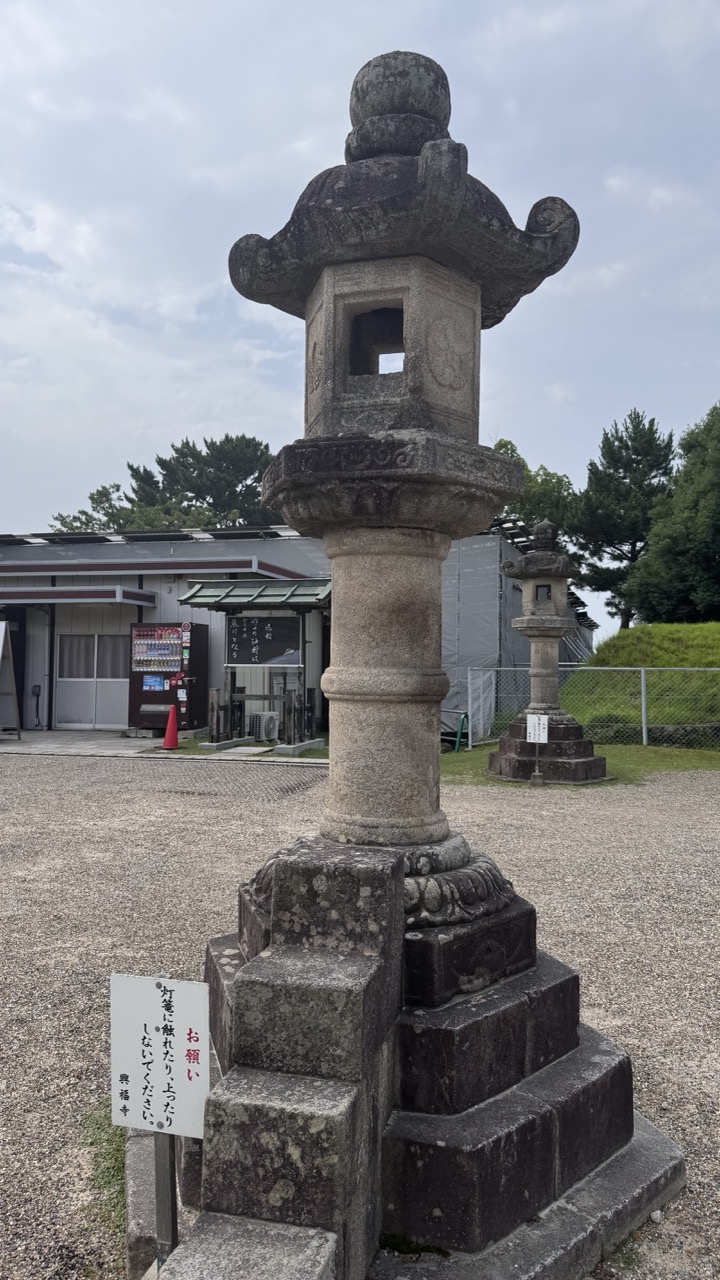

1. Overall Rating (0–10) — 6.0
This photograph presents a weathered stone lantern in a quiet temple setting, evoking a sense of age and stillness. The composition captures the lantern with dignity, yet the surrounding modern elements—like the vending machine and temporary structures—create a subtle tension between tradition and contemporary life. While the image effectively conveys the texture and history of the stone, it lacks the visual harmony needed to fully elevate the scene into a compelling work of art.
2. Composition (0–10) — 6.5
The lantern is well-centered, creating a strong focal point, but the cluttered background disrupts the balance. A tighter crop or shift in perspective could better isolate the subject and enhance visual harmony.
3. Lighting (0–10) — 6.0
The overcast sky provides soft, even lighting that highlights the texture of the stone without harsh shadows. However, the lack of directional light limits depth and mood, resulting in a somewhat flat and neutral atmosphere.
4. Color & Tone (0–10) — 5.5
The palette is dominated by muted grays and earth tones, which suit the subject’s solemnity but lack vibrancy. The subtle green of the trees offers a slight contrast, but the overall tonal range feels restrained and slightly dull.
5. Creativity (0–10) — 6.0
The image captures a moment of quiet observation, emphasizing the juxtaposition of ancient and modern elements. While not highly original in concept, it conveys a thoughtful narrative about time and place.
6. Technical Quality (0–10) — 7.5
The image is sharp and clear, with good detail in the stone textures. Focus is precise, and the exposure is well-balanced, capturing the scene without noticeable flaws.
7. Emotional Impact (0–10) — 5.5
There’s a contemplative quality to the image, inviting reflection on history and preservation. However, the presence of modern intrusions slightly weakens the emotional resonance, leaving the viewer with a sense of dissonance rather than deep connection.
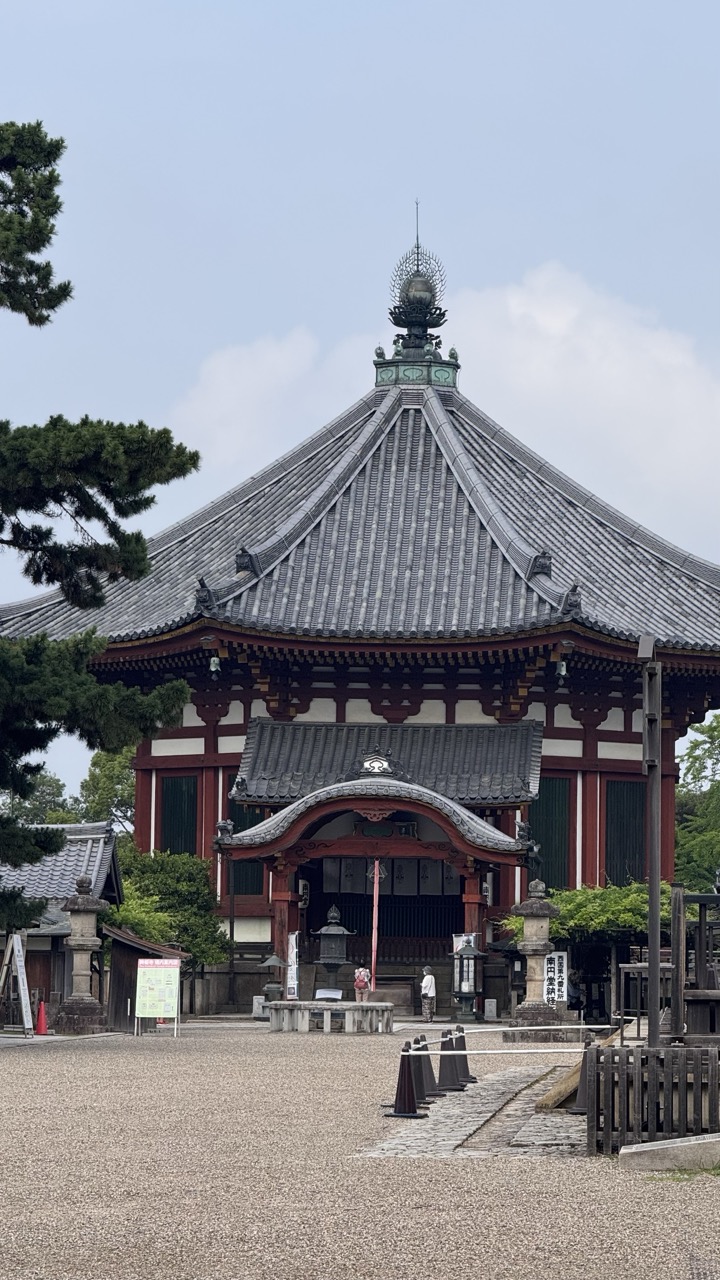

1. Overall Rating (0–10) — 7.5
This photograph captures the serene grandeur of a traditional Japanese temple, where architectural elegance meets spiritual stillness. The composition emphasizes the temple’s imposing form against a soft sky, with the gravel courtyard and surrounding greenery enhancing its tranquil atmosphere. While the image is visually balanced and rich in cultural detail, the slightly muted lighting and lack of dynamic contrast temper its emotional punch, keeping it more documentary than evocative.
2. Composition (0–10) — 8.0
The temple is centered and framed with strong symmetry, drawing the eye upward along its layered roofline. The foreground gravel and the tree on the left create natural leading lines, enhancing depth and grounding the structure in its environment.
3. Lighting (0–10) — 6.5
Soft, diffused daylight evenly illuminates the scene, minimizing harsh shadows and preserving architectural detail. However, the overcast sky lends a flat quality to the light, reducing tonal richness and atmospheric drama.
4. Color & Tone (0–10) — 7.0
The palette is restrained and harmonious, with earthy grays of the roof and stone contrasting gently against the deep reds of the wooden framework and the soft greens of the foliage. The overall tone is calm and balanced, though the muted saturation slightly dampens visual impact.
5. Creativity (0–10) — 7.0
The image successfully conveys the quiet dignity of a sacred space, relying on strong architectural lines and cultural context for its narrative. While not overtly experimental, it presents a thoughtful interpretation of tradition and space.
6. Technical Quality (0–10) — 8.0
The image is sharp and well-focused, with clear detail in the roof tiles, woodwork, and signage. The exposure is balanced, and the depth of field effectively keeps both foreground and background in view.
7. Emotional Impact (0–10) — 7.5
There is a quiet reverence in the image, evoking a sense of peace and contemplation. The stillness of the scene and the subtle human presence invite introspection, creating a gentle emotional resonance with the viewer.
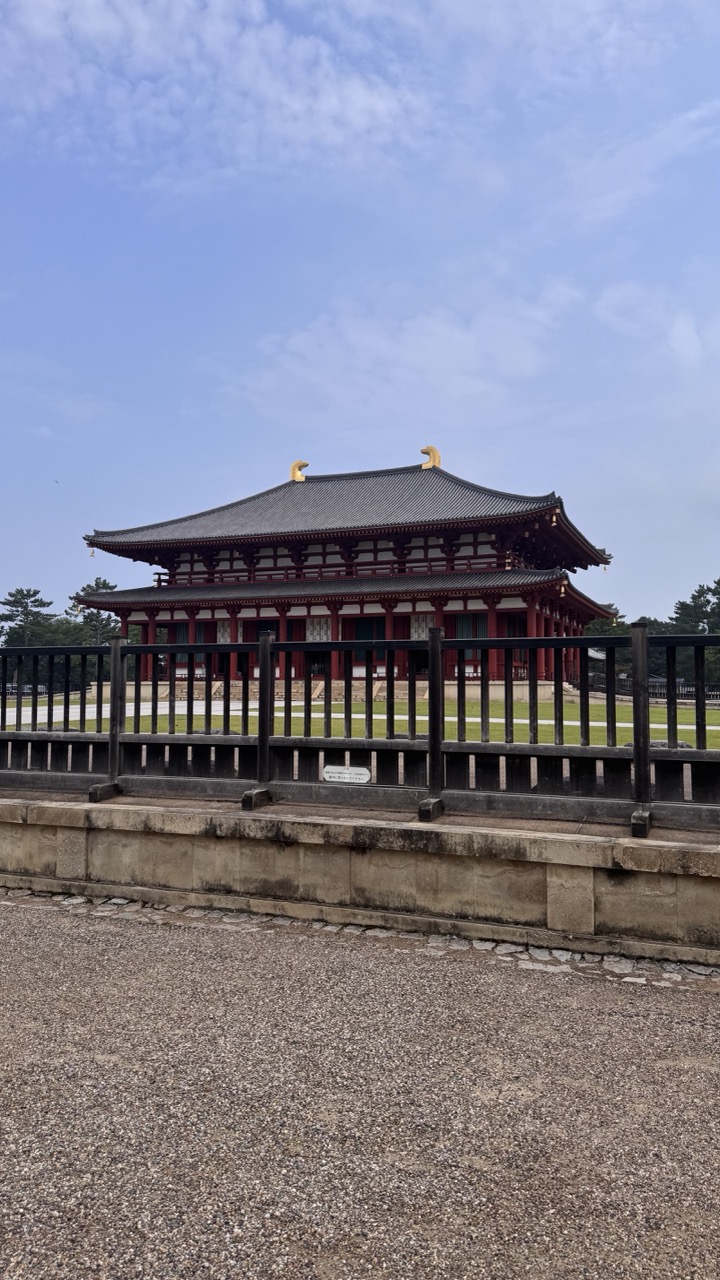

1. Overall Rating (0–10) — 7.0
This photograph captures the serene grandeur of a traditional Japanese temple, its red wood and sweeping roof harmonizing with the calm blue sky. The composition, though straightforward, effectively frames the structure as a focal point of cultural reverence. While the image conveys a sense of stillness and dignity, it lacks dynamic tension, holding back from deeper emotional resonance.
2. Composition (0–10) — 7.0
The temple is centered and well-framed, with the gravel foreground and black railing creating a layered depth. The low-angle perspective emphasizes the building’s scale, though the symmetry feels slightly rigid.
3. Lighting (0–10) — 7.5
Natural daylight enhances the clarity and detail of the temple’s architecture, with soft shadows that define its form. The even, bright lighting contributes to a peaceful and open atmosphere.
4. Color & Tone (0–10) — 7.0
The rich reds of the temple contrast beautifully with the deep blue sky and dark roof tiles. The palette is harmonious and restrained, emphasizing traditional aesthetics without over-saturation.
5. Creativity (0–10) — 6.5
The image presents a familiar subject with clarity and respect, but it follows a conventional travel photography approach. There’s little visual innovation or narrative twist to distinguish it from standard documentation.
6. Technical Quality (0–10) — 8.0
Sharp focus and clean detail throughout, with balanced exposure and no distracting artifacts. The image demonstrates strong technical control.
7. Emotional Impact (0–10) — 6.0
The scene evokes a sense of quiet contemplation and cultural reverence, but the emotional pull is restrained by the lack of human presence or personal storytelling.
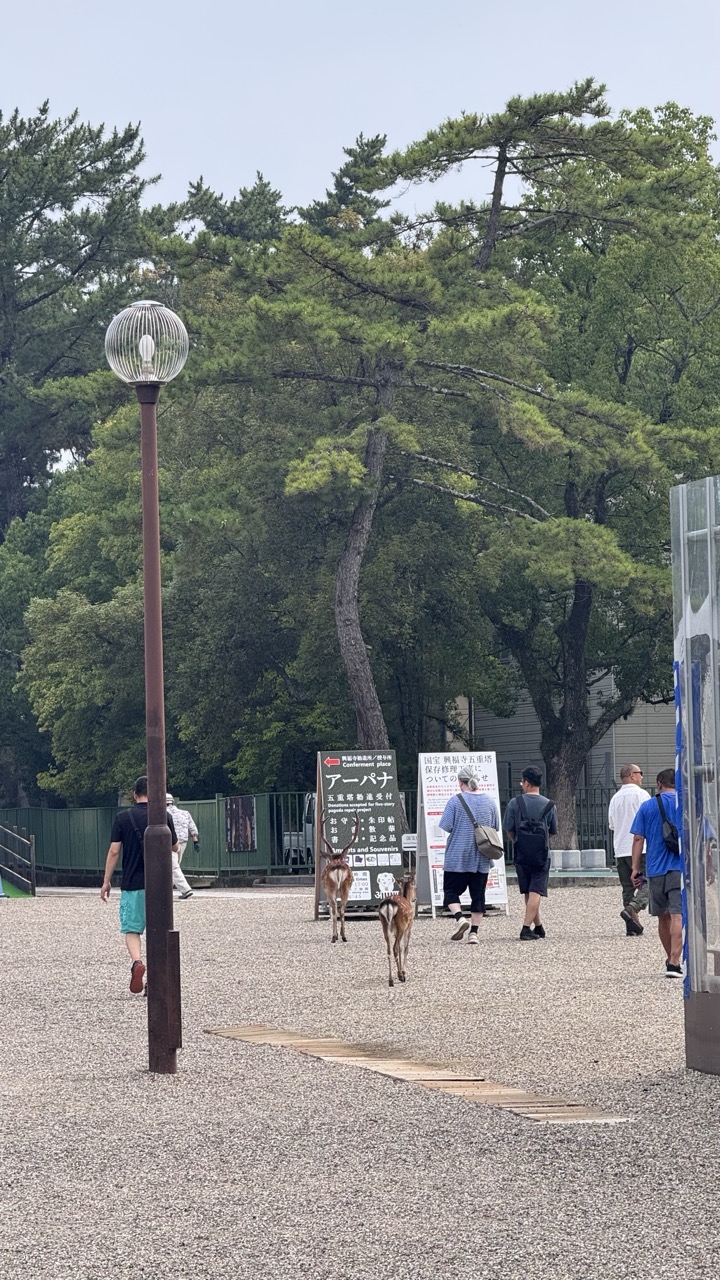

1. Overall Rating (0–10) — 6.0
This photograph captures a tranquil moment at a temple grounds, where deer and visitors coexist in a quiet, natural rhythm. The overcast sky and soft light lend a subdued, contemplative mood, while the presence of the deer adds a touch of whimsy and cultural resonance. Though the image is grounded in authenticity, it lacks visual dynamism and feels slightly passive, as if captured more as a memory than a statement.
2. Composition (0–10) — 5.5
The lamppost on the left creates a strong vertical element, but its dominance disrupts balance. The diagonal path and scattered figures provide movement, yet the framing feels slightly awkward, with the subjects trailing off toward the right edge.
3. Lighting (0–10) — 5.0
Diffused, overcast light flattens the scene, minimizing shadows and texture. While this creates even exposure, it also reduces depth and atmospheric richness.
4. Color & Tone (0–10) — 5.5
The palette is muted, dominated by greens and grays, with a lack of vibrancy that softens the overall impact. The natural tones are authentic but lack contrast or emotional warmth.
5. Creativity (0–10) — 6.0
The image captures a culturally significant moment—deer wandering freely among visitors—but the approach is observational rather than interpretive. There’s potential for storytelling, but it remains surface-level.
6. Technical Quality (0–10) — 7.0
Sharp focus and clean detail are present, particularly in the foreground. The exposure is balanced, though the image lacks the technical finesse to stand out.
7. Emotional Impact (0–10) — 5.0
The scene evokes a sense of calm and familiarity, but the lack of dramatic lighting or composition keeps the emotional connection subtle. It feels like a snapshot of a place rather than an invitation to feel.


1. Overall Rating (0–10) — 6.0
This photograph captures a striking juxtaposition between modern industrial architecture and traditional Japanese surroundings, creating a tension that speaks to cultural transition. The imposing gray structure dominates the frame, its utilitarian design contrasting sharply with the small wooden gate and stone wall in the foreground. While the image effectively documents this architectural collision, its emotional resonance is muted by a lack of dynamic composition and underwhelming lighting, leaving the scene feeling more like a snapshot than a compelling narrative.
2. Composition (0–10) — 5.5
The low-angle perspective emphasizes the building’s scale, but the cluttered foreground and off-center placement of the subject create visual imbalance. A tighter framing or more deliberate alignment with the crosswalk and signage could improve focus and harmony.
3. Lighting (0–10) — 5.0
Diffuse daylight under a cloudy sky provides even illumination but lacks depth and contrast. The flat lighting diminishes texture and detail, particularly on the building’s facade, resulting in a somewhat dull and unengaging atmosphere.
4. Color & Tone (0–10) — 5.5
The palette is dominated by cool grays and muted earth tones, creating a subdued and somber mood. While the blue pedestrian sign offers a small point of color, it does little to enliven the overall tone, which feels restrained and visually flat.
5. Creativity (0–10) — 6.5
The image succeeds in highlighting an intriguing contrast between old and new, suggesting a story of urban evolution. However, the lack of artistic framing or emotional nuance limits its originality, making it more documentary than imaginative.
6. Technical Quality (0–10) — 7.0
The image is sharp and clear, with good detail in the textures of the stone wall and building surface. Focus is consistent, and the exposure is well-balanced, though the overall technical execution is restrained by compositional choices.
7. Emotional Impact (0–10) — 5.0
The scene evokes a sense of quiet unease—of modernity encroaching upon tradition—but fails to fully engage the viewer emotionally. The distance created by the wide framing and neutral lighting prevents a deeper connection, leaving the image feeling detached and observational.
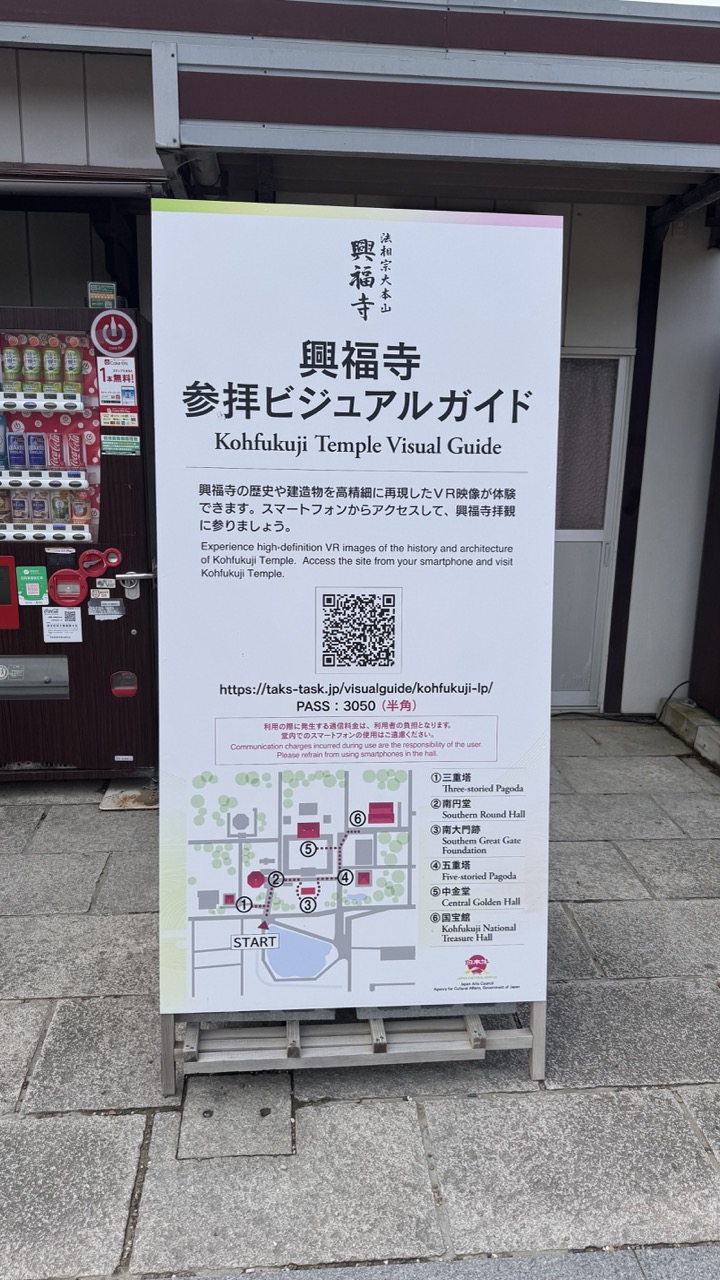

1. Overall Rating (0–10) — 5.0
This photograph captures a utilitarian visual guide for Kohfukuji Temple, presenting information in a straightforward, functional manner. While the sign is informative and clearly laid out, its presentation lacks visual appeal, feeling more like a public service notice than a compelling image. The cluttered background and flat lighting diminish its potential to engage, making it more documentary than artistic.
2. Composition (0–10) — 5.5
The sign is centered and framed adequately, but the surrounding elements—vending machine, door, and uneven pavement—introduce visual noise. The composition feels incidental rather than intentional, with the subject slightly off-kilter and the foreground distracting.
3. Lighting (0–10) — 5.0
The lighting is flat and diffused, typical of an overcast day, which flattens the image and reduces contrast. While the sign’s white background ensures legibility, the lack of directional light results in a lifeless, unremarkable tone.
4. Color & Tone (0–10) — 5.0
The palette is muted, dominated by neutral grays and whites, with only subtle pops of red and green from the vending machine and QR code. The color scheme is functional but uninspired, failing to evoke mood or atmosphere.
5. Creativity (0–10) — 4.5
The image is a straightforward documentation of a public sign, with no attempt at stylized framing or artistic interpretation. Its value lies in its informational content rather than creative expression.
6. Technical Quality (0–10) — 7.0
The image is sharp and clear, with legible text and a well-focused subject. The technical execution is sound, though the composition and lighting limit its overall impact.
7. Emotional Impact (0–10) — 4.0
The photograph feels impersonal and transactional, evoking little emotional response. It communicates information but fails to connect with the viewer on a deeper level, offering a glimpse into a place without conveying its spirit or significance.
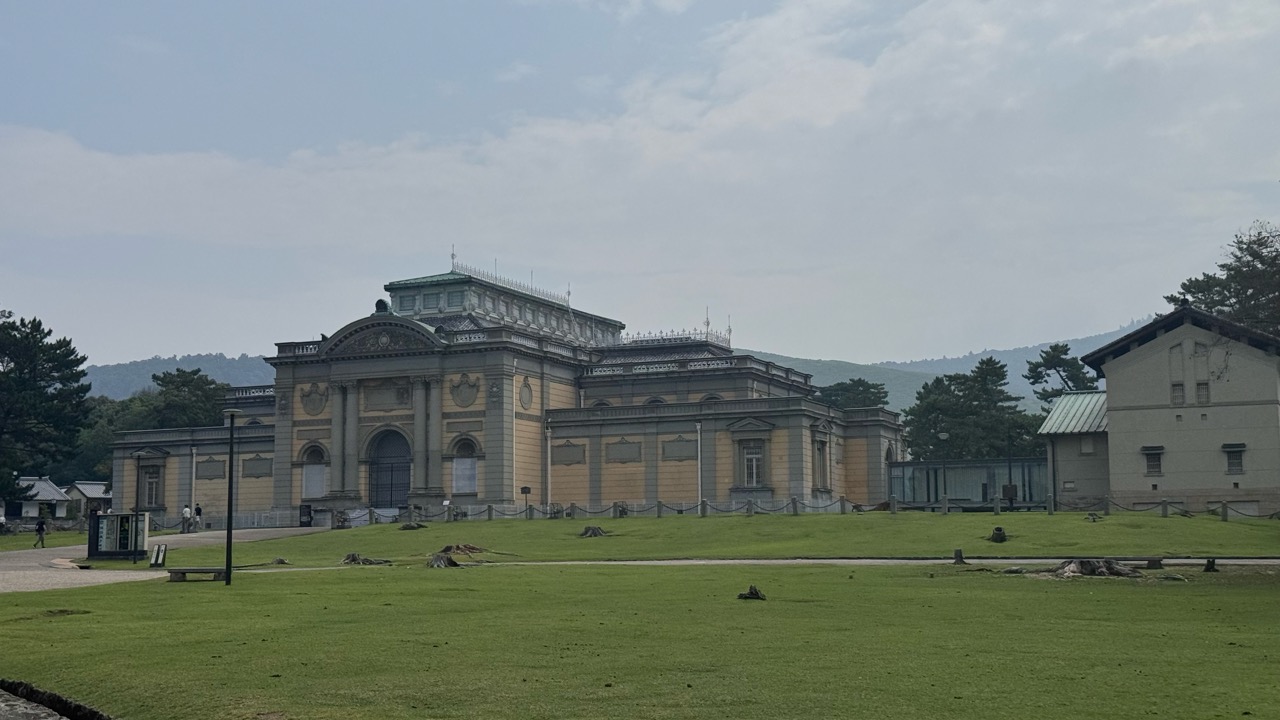

1. Overall Rating (0–10) — 6.8
This photograph captures the grandeur of a historic Western-style building set against a serene, natural backdrop, evoking a sense of timelessness and cultural convergence. The composition balances architectural detail with expansive landscape, though the overcast sky tempers the scene’s visual energy. While the image successfully documents the structure’s scale and setting, it holds back from fully conveying the emotional weight of its historical context.
2. Composition (0–10) — 7.0
The building is centered with a wide-angle perspective, emphasizing its architectural dominance. The foreground lawn provides visual breathing room, while the surrounding trees and hills frame the structure naturally, though the right-side building slightly disrupts balance.
3. Lighting (0–10) — 5.5
Diffuse, overcast lighting softens shadows and minimizes texture, creating a muted atmosphere. While this approach preserves detail across the scene, it reduces the dramatic contrast and depth that could enhance the building’s classical features.
4. Color & Tone (0–10) — 6.0
The palette is restrained, dominated by earthy yellows and greens with a pale sky. The tonal range is flat, lacking vibrancy, which diminishes the visual impact of the building’s ornate facade.
5. Creativity (0–10) — 6.5
The image offers a straightforward yet thoughtful documentation of a cultural landmark, capturing both its architectural elegance and integration with nature. While not artistically daring, it conveys a quiet narrative of heritage and place.
6. Technical Quality (0–10) — 7.5
The image is sharp and clear, with well-managed focus across the scene. The wide field of view is executed with precision, and noise is minimal despite the subdued lighting.
7. Emotional Impact (0–10) — 6.0
The photograph invites contemplation of history and design, but the lack of dynamic light and emotional contrast keeps the viewer at a distance. It feels more like an archival record than an evocative portrait.
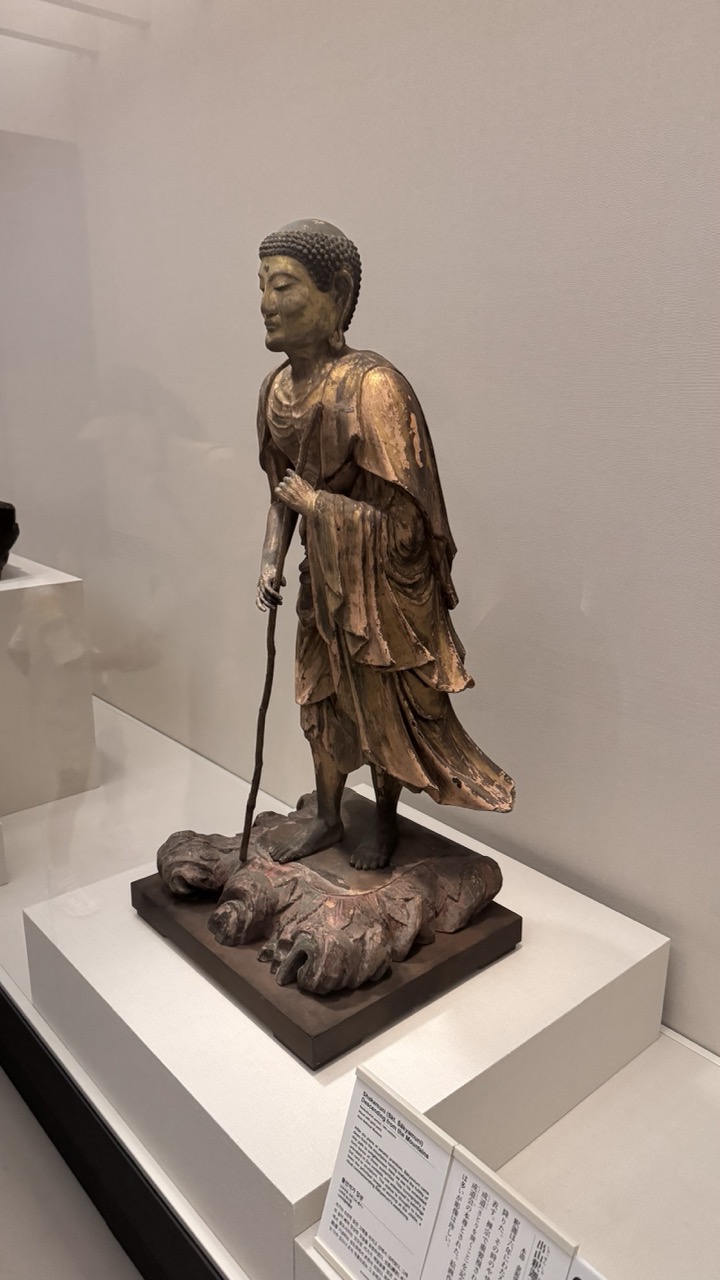

1. Overall Rating (0–10) — 7.0
This photograph captures the serene dignity of a wooden Buddha statue in a museum setting, where quiet reverence and historical weight are palpable. The composition balances the sculpture’s aged texture and spiritual presence against the clean, minimalist backdrop, allowing the viewer to focus on the artistry and craftsmanship. While the lighting and framing are functional, they slightly flatten the statue’s depth and narrative power, holding back the image from greater emotional resonance.
2. Composition (0–10) — 7.0
The statue is placed slightly off-center, creating a natural line of sight that draws the eye along its form. The low angle and visible base enhance the sculpture’s stature, while the clean white display platform and wall provide unobtrusive space. A tighter crop could better emphasize the figure’s detail and gesture.
3. Lighting (0–10) — 6.5
Even, diffused lighting highlights the texture and gilded patina of the wood without harsh shadows, though it lacks directional warmth that might enhance the spiritual atmosphere. The overall brightness is functional but neutral, failing to create dramatic contrast or mood.
4. Color & Tone (0–10) — 6.0
The palette is subdued, dominated by earthy golds and browns of the statue against a sterile white background. While the color temperature is neutral and accurate, it lacks vibrancy, giving the scene a documentary rather than an evocative feel.
5. Creativity (0–10) — 6.5
The image functions as a respectful document of the artifact, capturing its form and context. While not overtly artistic, the choice to include the informational plaque and surrounding space adds narrative depth, suggesting the statue’s cultural significance.
6. Technical Quality (0–10) — 8.0
Sharp focus on the statue ensures clarity in the wood grain and surface details. The exposure is well-balanced, with no blown highlights or lost shadows. The image is technically sound, with clean edges and minimal noise.
7. Emotional Impact (0–10) — 6.5
The stillness of the Buddha and the quiet gallery setting evoke contemplation and respect, but the lack of dynamic lighting and composition keeps the emotional connection restrained. The viewer is invited to observe, but not deeply moved.
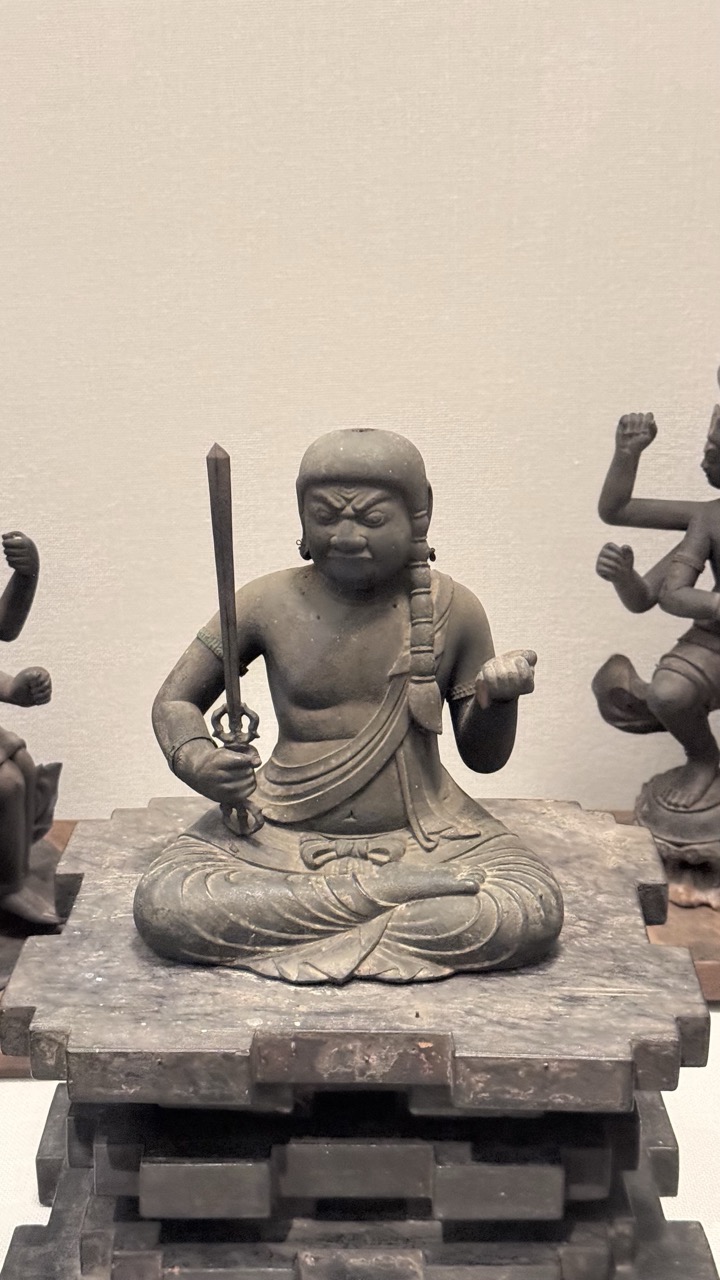

1. Overall Rating (0–10) — 7.0
This photograph captures the solemn power of a Buddhist guardian statue, its fierce expression and seated posture radiating spiritual authority. The dark, weathered metal and intricate details of the figure’s robes and weapon convey a sense of ancient craftsmanship, while the minimalist museum setting enhances the statue’s presence. A slightly tighter crop and more deliberate lighting could elevate the image from documentation to artistry.
2. Composition (0–10) — 6.5
The central figure is well-framed and balanced, though the partial inclusion of adjacent statues creates visual distraction. The stepped pedestal adds geometric depth, but the composition feels slightly crowded, pulling focus from the main subject.
3. Lighting (0–10) — 6.0
The lighting is even and functional, highlighting the texture of the metal, but lacks dramatic contrast or directional emphasis. A soft, angled light would better accentuate the statue’s features and depth.
4. Color & Tone (0–10) — 6.5
The monochromatic palette of dark grays and muted metallic tones is appropriate for the subject, but the overall tone is flat. A subtle warmth or enhanced contrast could add richness and dimension to the image.
5. Creativity (0–10) — 6.0
The image presents a strong cultural artifact with clear intent, but the approach is more documentary than interpretive. The mood is respectful and informative, but lacks a unique visual voice.
6. Technical Quality (0–10) — 7.5
The focus is sharp, the details are clear, and the image is free of noise. The lighting is controlled, and the texture of the sculpture is well-rendered.
7. Emotional Impact (0–10) — 6.5
The statue's intense gaze and commanding posture evoke a sense of spiritual guardianship, but the emotional resonance is muted by the sterile gallery environment and lack of atmospheric lighting.
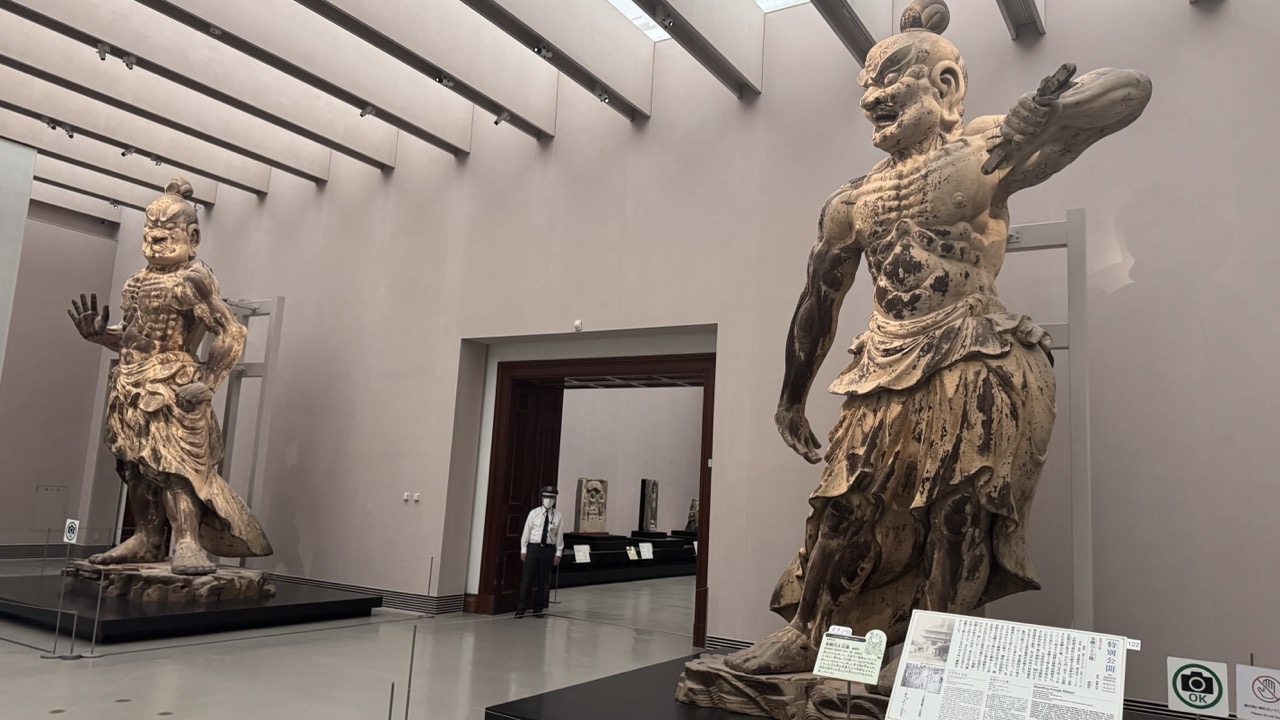

1. Overall Rating (0–10) — 7.0
This photograph captures the commanding presence of two monumental Buddhist guardian statues within a modern museum gallery, where ancient craftsmanship meets contemporary display. The scale and texture of the wooden figures are powerfully conveyed, and the clean architecture frames them with reverence. While the scene is visually compelling, the lack of dynamic lighting and slightly cluttered foreground detract from its artistic cohesion.
2. Composition (0–10) — 6.5
The statues are placed asymmetrically, creating visual tension, but the inclusion of the security guard and signage introduces a sense of dissonance. The wide-angle perspective emphasizes scale but slightly distorts the forms, particularly on the right.
3. Lighting (0–10) — 6.0
The lighting is functional and even, relying on overhead fixtures that flatten the texture of the wood. While it allows for clear visibility of the sculptures, it lacks the dramatic shadows and highlights that could enhance their three-dimensional presence.
4. Color & Tone (0–10) — 6.5
The palette is muted—dominated by beige, gray, and the earthy tones of the statues—creating a subdued, contemplative mood. The lack of vibrant color is appropriate for the subject, though a touch more contrast could make the textures pop.
5. Creativity (0–10) — 7.0
The image successfully juxtaposes ancient spiritual power with modern institutional space, offering a narrative about preservation and reverence. The inclusion of the guard adds a subtle human element, grounding the scene in reality.
6. Technical Quality (0–10) — 7.5
The image is sharp and well-focused, with clear detail on the statues and readable text on the informational placards. The exposure is balanced, though slight overexposure in the ceiling area slightly undermines the overall quality.
7. Emotional Impact (0–10) — 7.0
The statues exude a sense of awe and timelessness, their fierce expressions and weathered surfaces evoking a deep connection to history and devotion. The viewer is invited to contemplate both the artistry and the cultural weight of these ancient guardians.
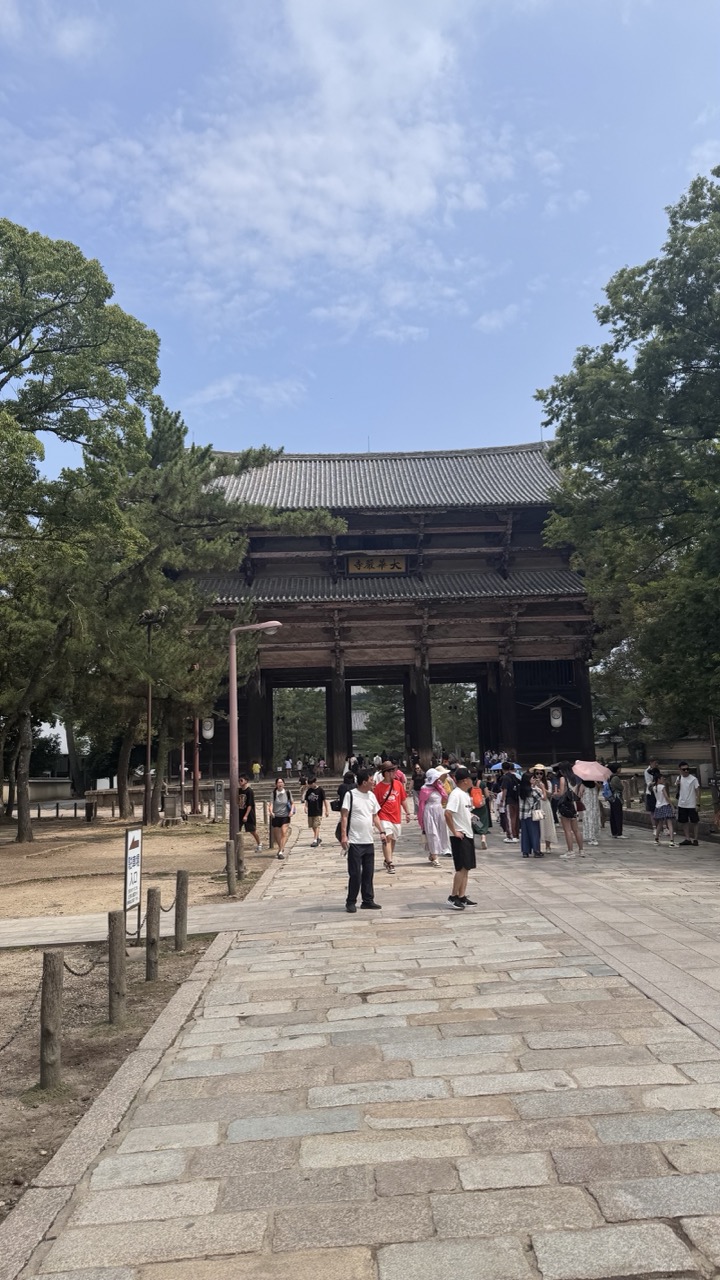

1. Overall Rating (0–10) — 6.8
This photograph captures the grandeur of a traditional Japanese temple gate under a bright, partly cloudy sky, with visitors adding life and scale to the scene. The composition draws the eye toward the imposing structure, emphasizing its cultural and architectural significance. While the image successfully conveys a sense of place and atmosphere, the lack of dramatic lighting and a slightly cluttered foreground detract from its visual impact, keeping it grounded in documentation rather than artistry.
2. Composition (0–10) — 7.0
The low-angle perspective enhances the gate’s imposing presence, while the stone path creates a strong leading line toward the entrance. The placement of people adds narrative depth, though the uneven distribution on the right side introduces slight imbalance.
3. Lighting (0–10) — 6.5
Natural daylight illuminates the scene evenly, highlighting the textures of the wood and stone. However, the flatness of the light under a partly overcast sky softens shadows and reduces visual drama.
4. Color & Tone (0–10) — 6.0
The palette is dominated by earthy tones—grays of the stone, dark wood, and lush green foliage—creating a harmonious but subdued atmosphere. The blue sky provides a gentle contrast, though the overall tone leans toward muted neutrality.
5. Creativity (0–10) — 6.5
The image effectively documents a cultural site with a sense of authenticity. The inclusion of tourists grounds the scene in the present, but the approach is conventional rather than artistically adventurous.
6. Technical Quality (0–10) — 7.5
Sharp focus across the frame ensures clarity in both foreground and background. The exposure is well-balanced, with no harsh highlights or lost shadows.
7. Emotional Impact (0–10) — 6.0
The photograph evokes a sense of reverence and quiet exploration, inviting the viewer to imagine stepping through the gate into a sacred space. While emotionally resonant, the connection remains surface-level due to the lack of a compelling focal moment.
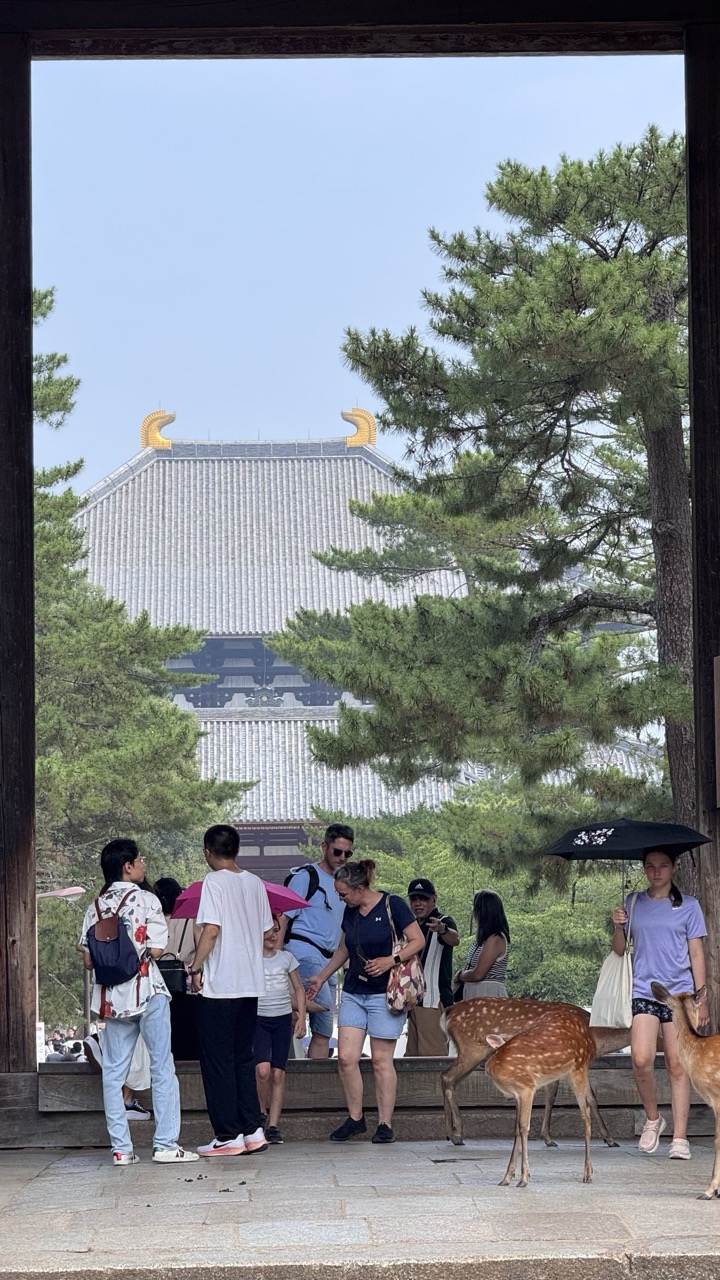

1. Overall Rating (0–10) — 7.0
This photograph captures a serene yet lively moment at a Japanese temple, where the harmony of nature, culture, and tourism converges. The framing through the wooden portal creates a natural vignette, drawing the eye to the iconic temple roof and the gentle presence of deer among visitors. While the scene is rich in cultural context and storytelling potential, the composition feels slightly crowded and the lighting is somewhat flat, dampening the image’s emotional resonance.
2. Composition (0–10) — 6.5
The wooden frame provides a strong visual structure, guiding the viewer toward the temple and the gathering of people and deer. However, the subjects are slightly scattered, and the deer on the right partially obscure the scene, creating a sense of visual clutter.
3. Lighting (0–10) — 6.0
Natural daylight is even and bright, allowing for clear visibility of details. However, the overcast sky results in a lack of strong shadows and contrast, giving the image a slightly washed-out quality.
4. Color & Tone (0–10) — 6.5
The palette is dominated by soft greens, grays, and earth tones, which harmonize well with the traditional setting. The golden roof details provide a subtle pop of color, but the overall tone is muted, limiting the image’s vibrancy.
5. Creativity (0–10) — 7.0
The use of the gate as a natural frame adds depth and narrative, suggesting a journey into a sacred space. The inclusion of deer and tourists creates a dynamic, layered scene that reflects the living culture of the location.
6. Technical Quality (0–10) — 7.5
The image is sharp and well-focused, with clean details in both the foreground and background. The exposure is balanced, and there is minimal noise, indicating a strong technical execution.
7. Emotional Impact (0–10) — 6.5
The photograph evokes a sense of peaceful coexistence and cultural wonder, but the lack of emotional intensity or a clear focal point keeps the viewer from fully connecting with the moment.
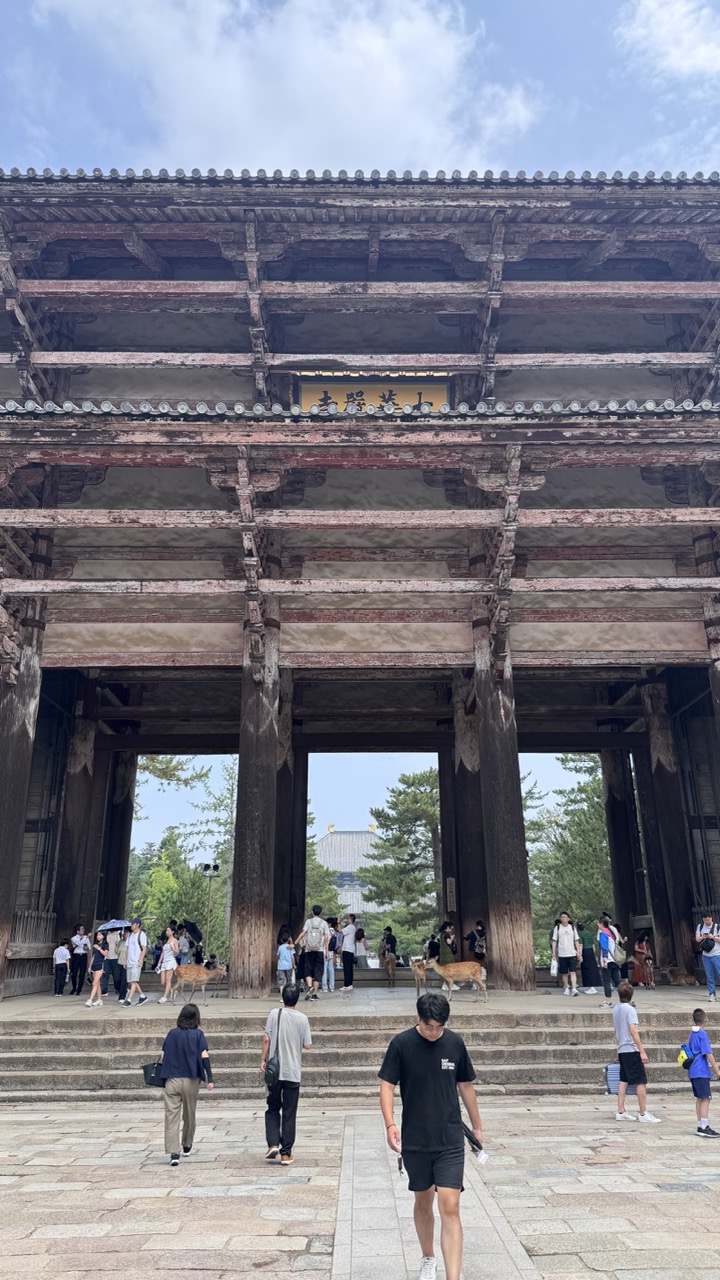

1. Overall Rating (0–10) — 7.0
This photograph captures the grandeur of a historic Japanese gate, where ancient architecture meets the rhythm of modern tourism. The imposing wooden structure, weathered by time, stands as a powerful testament to cultural endurance, while the presence of visitors and deer adds a layer of living tradition. Though the image feels slightly overexposed and lacks dramatic depth, its strength lies in conveying the site’s significance and accessibility—balancing reverence with everyday life.
2. Composition (0–10) — 7.5
The low-angle perspective emphasizes the gate’s scale and verticality, drawing the eye upward through its layered beams. The central alignment of the arches creates strong leading lines, guiding the viewer’s gaze through the frame. However, the inclusion of too many people and foreground activity slightly disrupts the visual harmony.
3. Lighting (0–10) — 6.0
Bright, midday sunlight illuminates the scene evenly but flattens textures and shadows, reducing the depth and atmospheric richness. The sky’s slight overexposure further diminishes contrast, softening the mood of the moment.
4. Color & Tone (0–10) — 6.5
The palette is dominated by earthy browns and muted grays, reflecting the aged wood and stone. The green of the trees offers a subtle contrast, but the overall tone feels slightly washed out, lacking vibrancy and emotional warmth.
5. Creativity (0–10) — 7.0
The image successfully blends historical reverence with contemporary life, using the juxtaposition of ancient structure and modern visitors as a narrative device. The inclusion of deer adds an element of cultural uniqueness, elevating the scene beyond mere documentation.
6. Technical Quality (0–10) — 7.5
The focus is sharp across the frame, capturing fine details in the woodwork and architecture. The resolution is high, and the exposure is generally well-managed, though the bright sky suggests minor overexposure.
7. Emotional Impact (0–10) — 7.0
The image evokes a sense of awe and continuity—connecting past and present through shared space. The human and animal presence adds warmth and life, inviting the viewer to feel both the weight of history and the joy of experience.
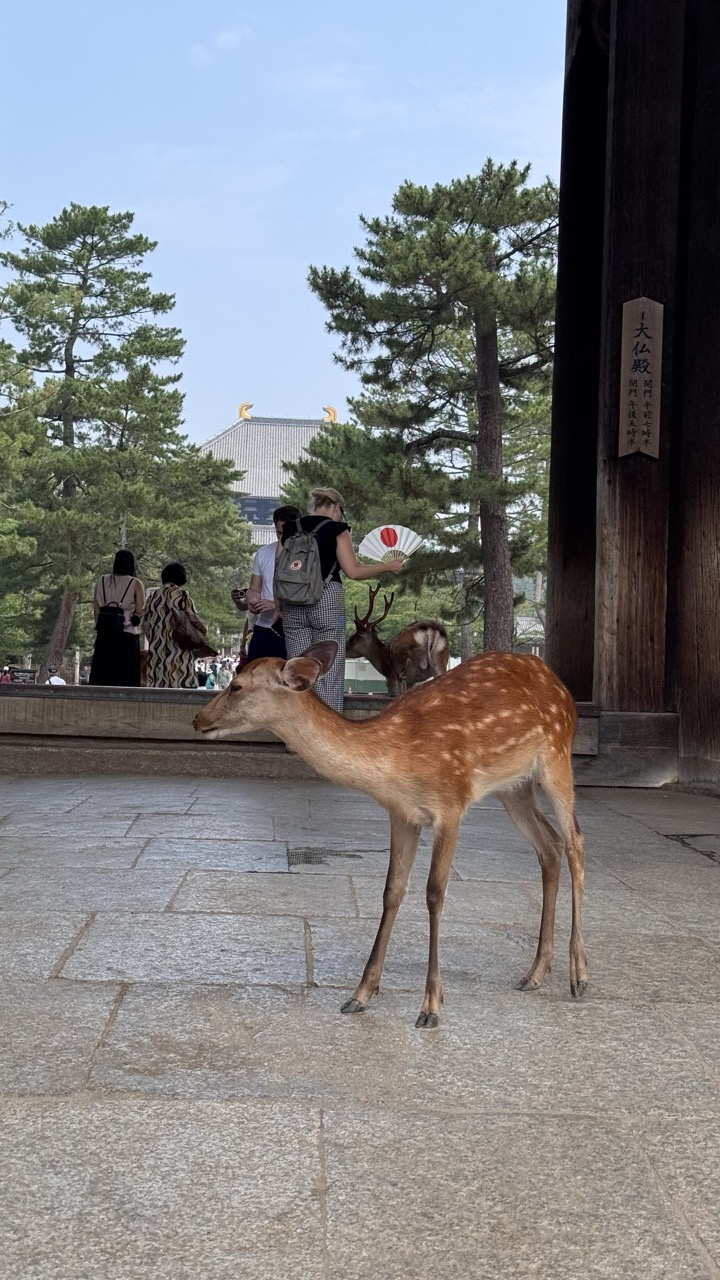

1. Overall Rating (0–10) — 7.0
This photograph captures a serene yet dynamic moment at a sacred Japanese temple, where nature and human presence coexist in quiet harmony. The foreground deer, poised and alert, draws the eye, while the background reveals cultural depth through architecture and visitors. While the image successfully conveys the atmosphere of Nara’s iconic setting, its emotional resonance is slightly diluted by a lack of visual cohesion and overexposure in the sky.
2. Composition (0–10) — 6.5
The deer is well-placed in the lower third, creating a strong focal point, but the busy background and uneven framing—especially the heavy wooden post on the right—distract from the subject. A tighter crop could improve balance and focus.
3. Lighting (0–10) — 6.0
Natural daylight illuminates the scene evenly, but the sky is slightly overexposed, washing out detail and creating a flat contrast. The light is soft and diffused, lending a calm mood, yet lacks directional depth to enhance texture or mood.
4. Color & Tone (0–10) — 6.5
The warm brown of the deer’s coat contrasts gently with the cool grays of the stone and the deep greens of the trees. The palette is natural and cohesive, though muted by the bright sky, which slightly flattens the overall tonal range.
5. Creativity (0–10) — 7.0
The image captures a quintessential moment in Nara—tourists, deer, and temple architecture in harmony—offering a narrative of cultural coexistence. The inclusion of the fan and the wooden sign adds layers of storytelling, grounding the scene in place and tradition.
6. Technical Quality (0–10) — 7.5
The focus is sharp on the deer, and the details of its fur and the surrounding environment are clear. The image is well-exposed overall, though the sky’s brightness detracts from the scene’s subtlety.
7. Emotional Impact (0–10) — 6.5
There’s a sense of peaceful coexistence that evokes curiosity and wonder, particularly in the deer’s calm demeanor and the quiet reverence of the visitors. While not deeply stirring, the image succeeds in conveying a tranquil, lived-in moment.
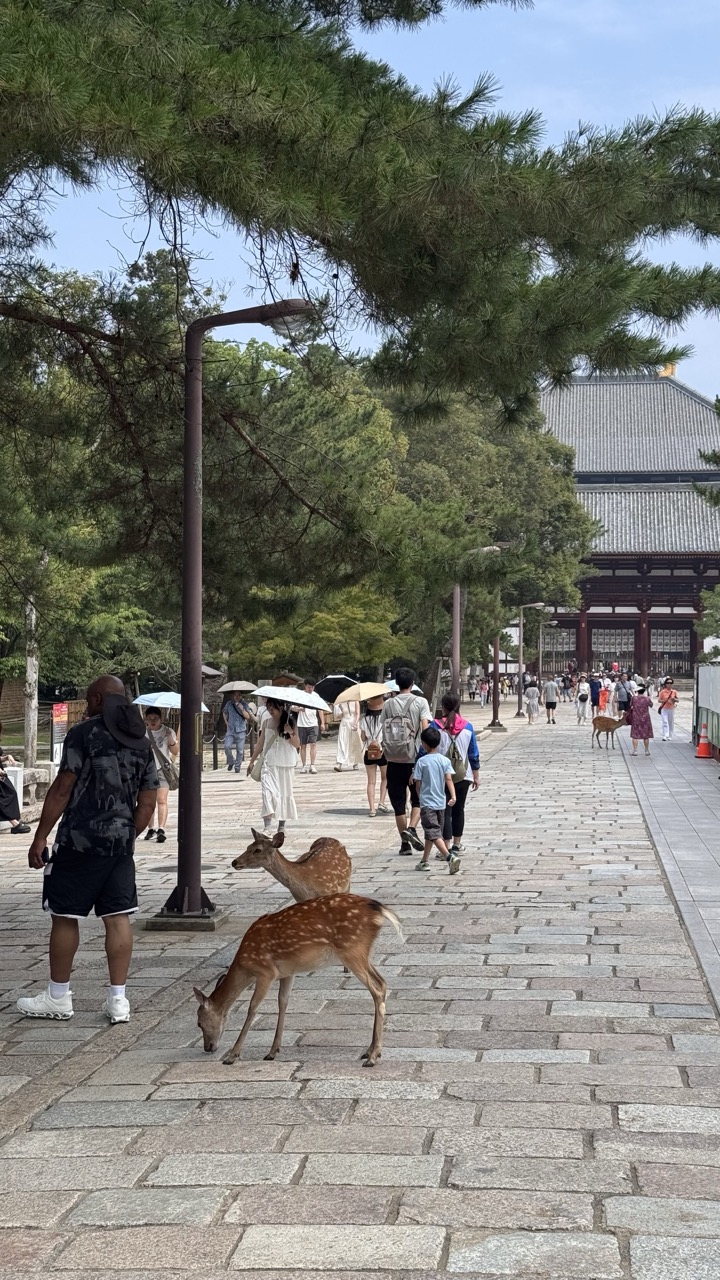

1. Overall Rating (0–10) — 7.0
This photograph captures a serene yet lively moment at a historic Japanese temple, where nature and human activity coexist in gentle harmony. The presence of deer grazing among visitors adds a sense of wonder and cultural authenticity, while the traditional architecture and lush greenery ground the scene in place and time. Though the image is visually engaging, the composition’s busyness slightly dilutes its emotional focus, leaving the viewer with a snapshot of a moment rather than a deeply resonant narrative.
2. Composition (0–10) — 6.0
The wide-angle perspective creates a sense of depth, but the scattered placement of people and deer across the frame results in a lack of visual hierarchy. The leading lines of the stone path guide the eye toward the temple, but the foreground activity distracts from this directionality.
3. Lighting (0–10) — 7.0
Natural daylight provides even illumination, with soft shadows suggesting a midday sun. The lighting enhances the textures of the stone pavement and pine needles, while the overcast sky prevents harsh contrasts, contributing to a calm, balanced mood.
4. Color & Tone (0–10) — 6.5
The palette is composed of earthy greens, grays, and browns, reflecting the natural and architectural elements. While harmonious, the colors lean toward muted tones, reducing visual vibrancy. A subtle warmth in the sunlight could have enhanced the scene’s inviting atmosphere.
5. Creativity (0–10) — 7.5
The image captures a unique cultural experience—deer freely roaming among tourists at a sacred site—offering a rare blend of wildlife and tradition. The juxtaposition of modern visitors with ancient surroundings lends the photograph a sense of narrative richness and authenticity.
6. Technical Quality (0–10) — 7.5
The focus is sharp across the midground, allowing clear detail in both the deer and the temple. The image is free of noticeable digital noise, and the exposure is well-balanced, preserving detail in both highlights and shadows.
7. Emotional Impact (0–10) — 7.0
There is a quiet charm in the scene’s peaceful coexistence of people and animals, evoking a sense of wonder and tranquility. The viewer is invited to imagine the sounds of footsteps, rustling leaves, and distant temple bells, creating a moment of quiet contemplation.
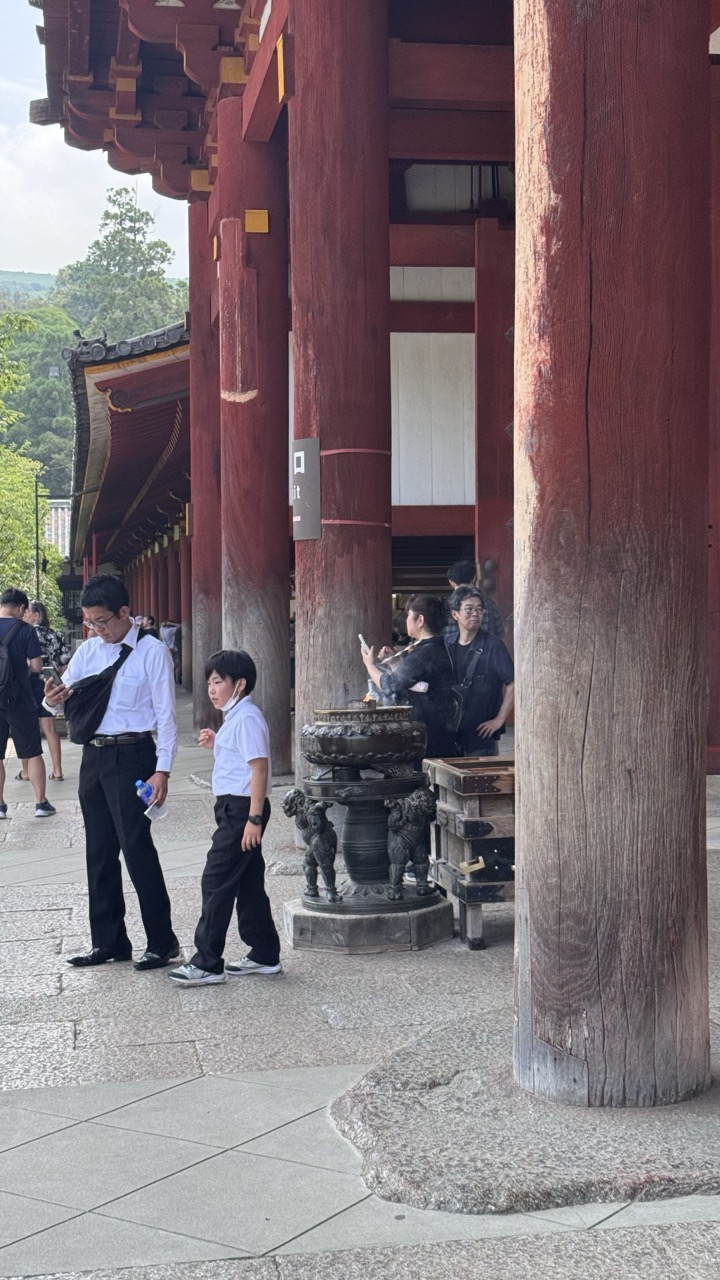

1. Overall Rating (0–10) — 6.0
This photograph captures a candid moment within a traditional Japanese temple complex, where the interplay of architectural grandeur and everyday human activity creates a quiet narrative of cultural continuity. The bold red pillars and intricate woodwork provide a strong visual anchor, grounding the scene in authenticity, while the casual presence of visitors lends a sense of lived-in realism. However, the composition feels slightly overwhelmed by foreground elements and lacks a clear focal point, preventing the image from achieving a more compelling balance between place and people.
2. Composition (0–10) — 5.5
The framing is slightly cluttered, with the large pillar on the right and the foreground elements creating visual tension. The placement of the incense burner and the group of people disrupts the flow, while the diagonal line of the temple roof adds dynamic tension but doesn’t fully guide the eye.
3. Lighting (0–10) — 6.0
Natural daylight provides even illumination, though it is somewhat diffused, softening the textures of the wood and stone. The light highlights the depth of the temple’s structure but doesn’t create strong contrasts or dramatic shadows, giving the scene a neutral, documentary quality.
4. Color & Tone (0–10) — 6.5
The dominant red of the pillars provides a rich, culturally resonant color, balanced by the neutral grays of the pavement and the muted tones of the visitors’ clothing. The overall palette is harmonious but restrained, with little vibrancy to elevate the image.
5. Creativity (0–10) — 5.5
The image succeeds as a slice-of-life document, capturing the rhythm of a sacred space in motion. However, it lacks a strong conceptual or emotional hook, relying more on context than artistic interpretation.
6. Technical Quality (0–10) — 7.0
The focus is sharp, particularly on the central figures and the incense burner, with good detail visible in the wood grain and architectural elements. The exposure is well-balanced, with no blown-out highlights or crushed shadows.
7. Emotional Impact (0–10) — 5.0
While the setting evokes a sense of reverence and tradition, the emotional connection is muted. The casual demeanor of the subjects and the busy environment prevent a deeper sense of contemplation or stillness, leaving the viewer as an observer rather than a participant.
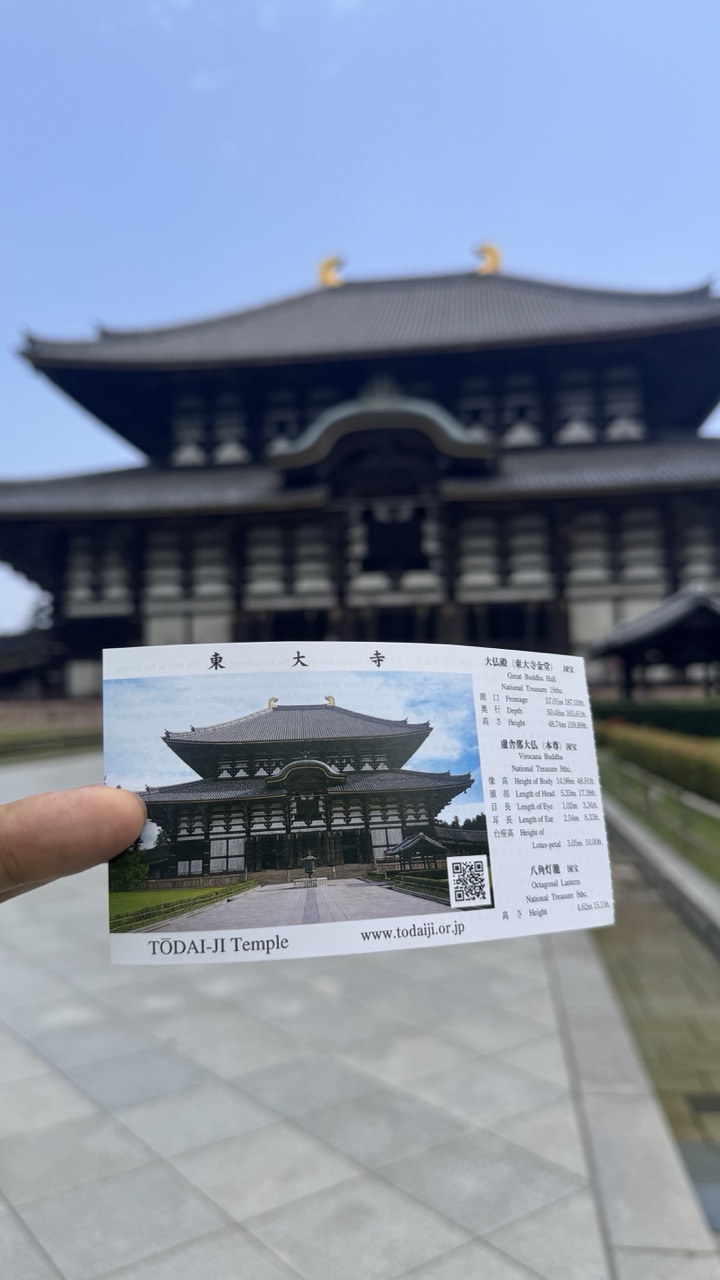

1. Overall Rating (0–10) — 6.0
This photograph captures a layered moment of travel and place, where a physical postcard merges with the real-world landmark it represents. The juxtaposition of the printed image and the actual temple creates a meta-narrative about memory and documentation, though the shallow depth of field and awkward framing slightly undermine its visual cohesion. While the idea is conceptually strong, the execution feels more like a casual snapshot than a polished composition.
2. Composition (0–10) — 5.5
The hand holding the postcard dominates the foreground, creating a sense of immediacy but also disrupting the symmetry of the temple behind. The focus on the card and the blurred background creates a disjointed visual flow, with the temple appearing secondary despite its significance.
3. Lighting (0–10) — 7.0
Natural daylight illuminates the scene evenly, with soft shadows that enhance the texture of the temple’s wood and tile. The clear blue sky adds depth and contrast, though the overexposure on the card slightly flattens its details.
4. Color & Tone (0–10) — 6.5
The palette is balanced between the earthy browns and greys of the temple and the cool blue of the sky, with the white of the postcard providing a clean visual anchor. However, the color reproduction on the card appears slightly washed out, reducing the richness of the scene.
5. Creativity (0–10) — 7.0
The image explores the relationship between representation and reality in a clever way, using the postcard as both subject and frame. This conceptual layer adds depth beyond a simple travel photo, though the idea is not fully realized in the final composition.
6. Technical Quality (0–10) — 6.0
The focus is sharp on the postcard but soft on the temple, creating a mismatch in clarity. The image is generally well-exposed, but the slight blur and digital noise in the lower portion reduce overall technical precision.
7. Emotional Impact (0–10) — 6.0
The photograph evokes a sense of personal connection to a place, as if preserving a memory in the act of capturing it. However, the distance created by the postcard and the lack of human presence in the background limit its emotional resonance.
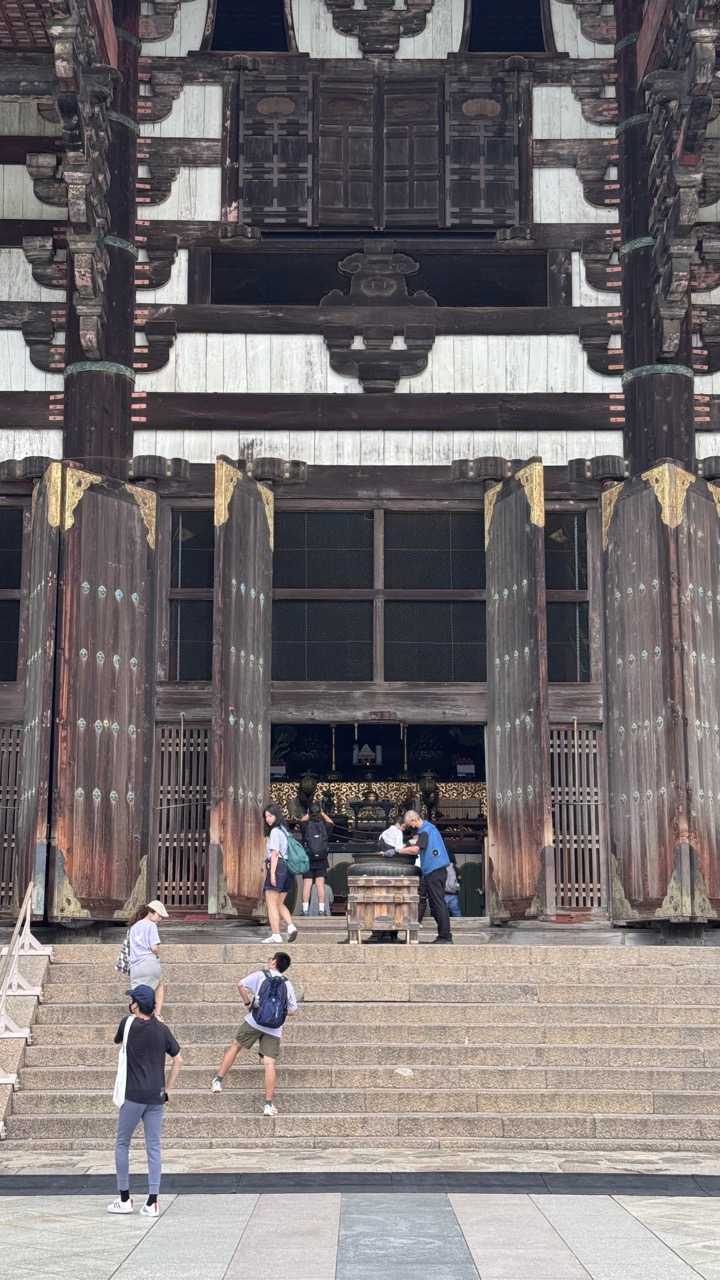

1. Overall Rating (0–10) — 7.0
This photograph captures the grandeur of a traditional Japanese temple entrance, where centuries-old craftsmanship meets the rhythm of modern life. The towering wooden structure, with its intricate joinery and weathered patina, commands attention, while the presence of visitors adds a sense of scale and continuity. Though the image is strong in atmosphere and detail, the composition feels slightly overexposed and the framing could better emphasize the temple’s verticality.
2. Composition (0–10) — 6.5
The low-angle perspective enhances the temple’s imposing scale, but the wide shot includes too much foreground clutter. The stairs and tourists create visual distraction, pulling focus from the central architectural details.
3. Lighting (0–10) — 6.0
Bright daylight illuminates the scene clearly, but the harsh overhead light flattens textures and washes out subtle tonal variations in the wood. Some shadows under the eaves are too deep, losing detail.
4. Color & Tone (0–10) — 6.5
The palette is dominated by natural wood tones and muted grays, giving the image a grounded, historical feel. The golden accents on the door brackets offer a subtle contrast, but the overall tone is slightly flat and lacks vibrancy.
5. Creativity (0–10) — 7.0
The juxtaposition of ancient architecture with contemporary visitors creates a compelling narrative of cultural endurance. The image successfully blends history and present-day life in a way that feels both documentary and reflective.
6. Technical Quality (0–10) — 7.5
The image is sharp and well-focused, with clean detail in the wood grain and structural elements. The digital clarity allows for appreciation of the craftsmanship, though slight overexposure in the sky and highlights detracts from overall balance.
7. Emotional Impact (0–10) — 7.0
There’s a quiet reverence in the scene—visitors move with reverence, the temple stands as a silent witness. The image evokes a sense of timelessness and continuity, inviting the viewer to pause and reflect on the enduring presence of tradition.
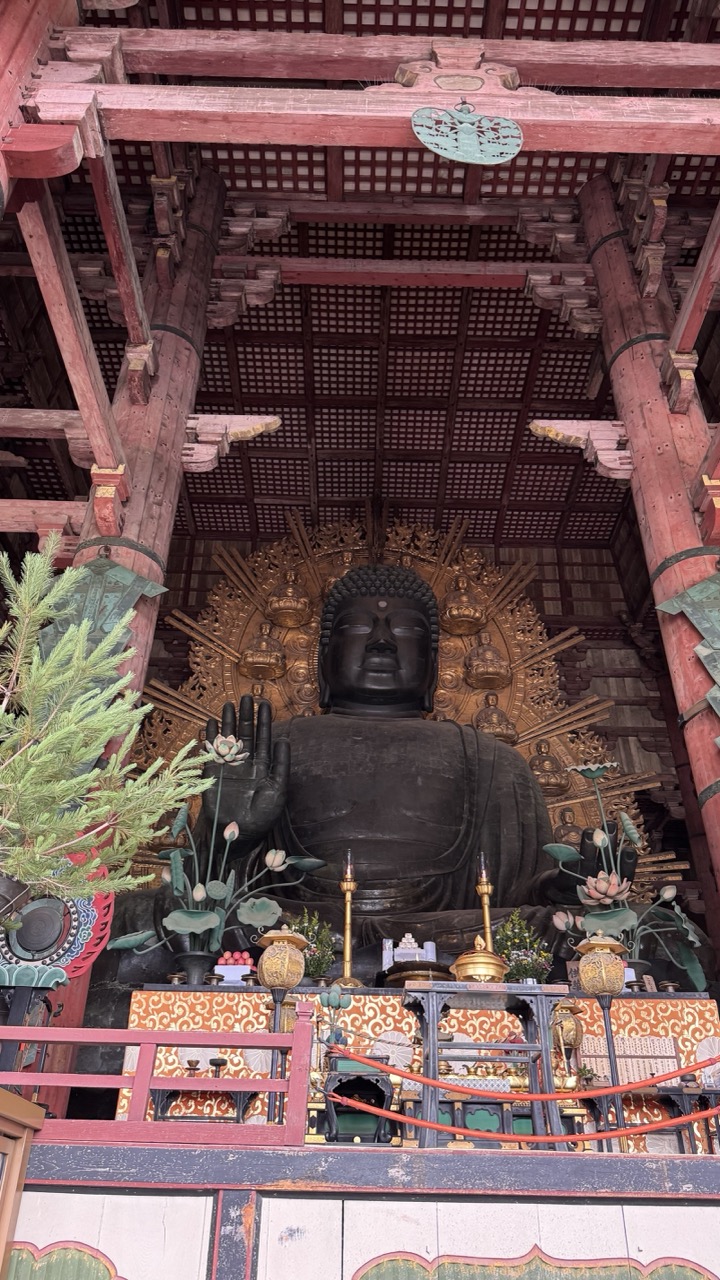

1. Overall Rating (0–10) — 7.5
This photograph captures the awe-inspiring scale and spiritual gravity of the Great Buddha of Todai-ji, its immense form framed by the temple’s wooden architecture. The composition draws the eye upward, emphasizing the statue’s dominance and the reverence of the space. While the image is rich in cultural and architectural detail, a more deliberate use of lighting and depth could further enhance its dramatic presence.
2. Composition (0–10) — 7.0
The low-angle perspective enhances the statue’s grandeur, with the wooden beams and railings creating a natural frame. The placement of the Buddha at the center provides balance, though the foreground elements slightly clutter the lower edge.
3. Lighting (0–10) — 6.0
Natural light filters in from above, casting soft shadows that highlight the Buddha’s serene features. However, the overall exposure is slightly dim, muting the contrast between the dark statue and the golden halo.
4. Color & Tone (0–10) — 7.0
The warm reds of the wood and the gold of the halo create a harmonious palette, while the deep black of the Buddha offers strong visual contrast. The green foliage adds a touch of organic life, grounding the sacred space in nature.
5. Creativity (0–10) — 7.5
The image successfully conveys the solemnity and historical weight of the site. The framing and perspective reflect a respectful yet artistically engaged approach to capturing a landmark of cultural significance.
6. Technical Quality (0–10) — 7.5
The image is sharp and clear, with fine detail visible in the woodwork and the statue’s surface. Focus is well-managed, and the depth of field appropriately captures both foreground and background elements.
7. Emotional Impact (0–10) — 8.0
The photograph evokes a sense of reverence and contemplation, inviting the viewer to feel the stillness and spiritual weight of the space. The scale and serenity of the Buddha resonate deeply, creating a moment of quiet awe.
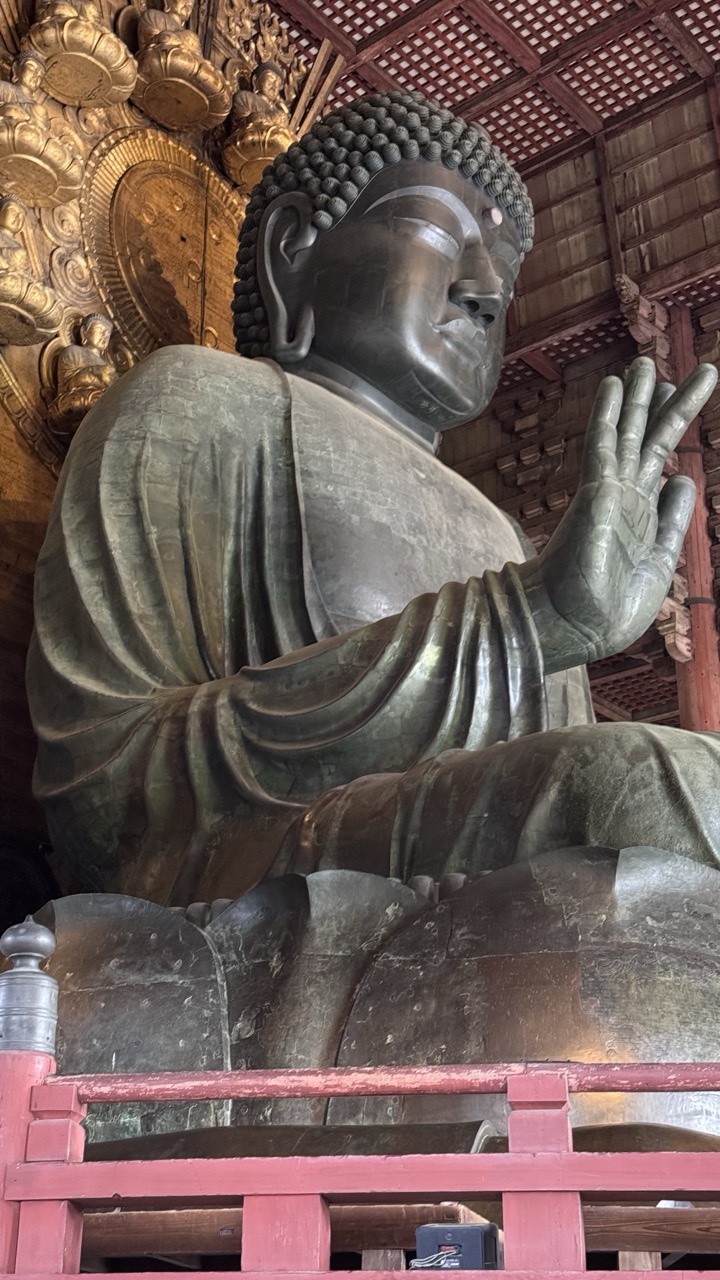

1. Overall Rating (0–10) — 8.0
This photograph captures the serene grandeur of the Great Buddha of Nara with a powerful sense of reverence and scale. The composition emphasizes the statue’s monumental presence, while the interplay of light and shadow across the bronze surface enhances its timeless dignity. A slightly tighter framing could further focus attention on the Buddha’s face, but the image successfully conveys both the spiritual weight and architectural context of the scene.
2. Composition (0–10) — 7.5
The statue is centered with a strong diagonal line created by the red railing in the foreground, guiding the eye toward the Buddha’s face. The inclusion of the ornate golden halo adds depth and cultural richness, though the foreground railing slightly disrupts the visual flow.
3. Lighting (0–10) — 7.0
Soft, diffused light from above highlights the contours of the Buddha’s face and hand, creating subtle shadows that emphasize the texture of the bronze. The lighting enhances the contemplative mood without casting harsh glares.
4. Color & Tone (0–10) — 7.5
The deep green patina of the bronze contrasts beautifully with the warm gold of the halo and the red of the wooden structure. The muted, earthy palette reinforces the historical and spiritual atmosphere of the space.
5. Creativity (0–10) — 7.0
The image captures a familiar subject with a fresh perspective by integrating the architectural elements and the viewer’s vantage point. The framing suggests both reverence and accessibility, inviting contemplation.
6. Technical Quality (0–10) — 8.0
The image is sharp and detailed, particularly in the texture of the bronze and the intricate carvings. Focus is well-managed, and the exposure is balanced, preserving detail in both highlights and shadows.
7. Emotional Impact (0–10) — 8.5
There is a profound sense of peace and awe, evoked by the Buddha’s calm expression and the sacred environment. The viewer is drawn into a moment of quiet reflection, feeling the weight of centuries of devotion.
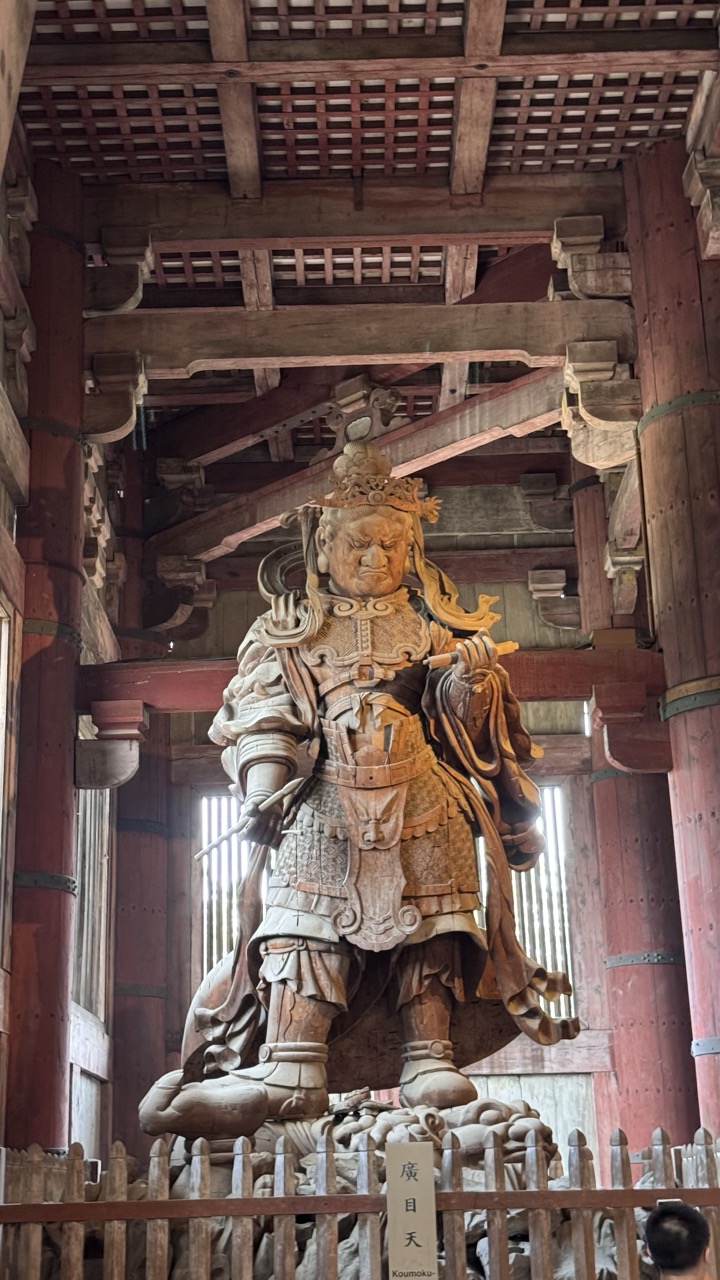

1. Overall Rating (0–10) — 7.5
This photograph captures the imposing presence of a colossal wooden guardian statue within a traditional Japanese temple hall, where craftsmanship and spiritual weight converge. The statue’s fierce expression and intricate armor are rendered with striking detail, while the surrounding wooden architecture enhances its sacred context. The image balances reverence and scale well, though the framing feels slightly cluttered by the foreground railing and partial view of a visitor, slightly diminishing the monumentality.
2. Composition (0–10) — 6.5
The statue is centered and dominates the frame, emphasizing its significance, but the foreground fence and the partial head of a visitor disrupt visual flow and create a sense of intrusion. A tighter crop could enhance focus on the statue’s full form and the architectural details above.
3. Lighting (0–10) — 7.0
Natural light filters through the windows on either side, casting soft, directional highlights that accentuate the texture and depth of the wood carving. The interplay of light and shadow enhances the statue’s three-dimensionality, while the overall lighting remains even and warm, supporting the solemn atmosphere.
4. Color & Tone (0–10) — 7.5
The palette is rich with warm, earthy tones—natural wood hues, deep reds in the beams, and subtle grays in the shadows—creating a harmonious and historically grounded feel. The tonal contrast is balanced, allowing the sculpture to stand out without overwhelming the space.
5. Creativity (0–10) — 7.0
The image captures a moment of quiet awe, framing the statue not just as an artifact but as a living presence within its sacred environment. The inclusion of the visitor’s head subtly grounds the scene in reality, adding a narrative layer of human reverence.
6. Technical Quality (0–10) — 8.0
The image is sharp and detailed, with clear focus on the statue and fine texture in the wood grain. The exposure is well-managed, preserving both highlights and shadows without harsh clipping.
7. Emotional Impact (0–10) — 8.0
There’s a powerful sense of awe and reverence evoked by the statue’s imposing stance and the sacred setting. The viewer is invited to feel both the grandeur of the craftsmanship and the quiet solemnity of the space, creating a deeply resonant experience.
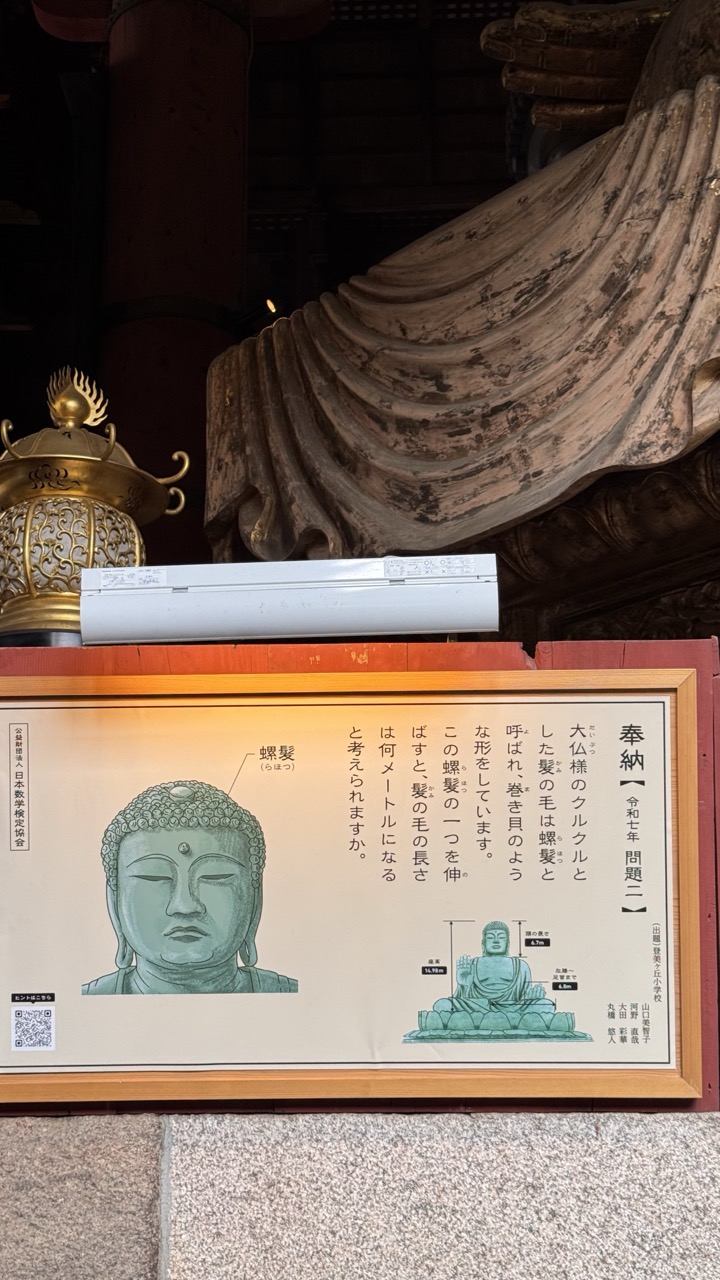

1. Overall Rating (0–10) — 6.0
This photograph juxtaposes the sacred and the mundane, capturing a moment where spiritual reverence collides with modern functionality. The towering wooden Buddha looms over a didactic sign and a modern air conditioning unit, creating a tension between tradition and contemporary life. While the image offers a compelling narrative of cultural continuity, the intrusive presence of the AC unit disrupts the spiritual atmosphere, and the composition feels more observational than artistically resolved.
2. Composition (0–10) — 5.5
The framing is slightly cluttered, with the air conditioning unit and sign dominating the lower half and partially obscuring the sacred elements. The large Buddha arm in the upper right creates a strong diagonal, but the composition lacks balance due to the visual weight of the modern elements.
3. Lighting (0–10) — 5.0
Natural light filters in from above, creating soft shadows that emphasize texture on the wooden sculpture. However, the lighting is uneven, with the lower portion of the image appearing darker and less defined, reducing the clarity of the sign and surrounding details.
4. Color & Tone (0–10) — 5.5
The palette is subdued, dominated by earthy browns of the wood and the beige of the sign, punctuated by the gold of the incense burner. The green tint of the Buddha illustration on the sign adds a subtle contrast, but the overall tone lacks vibrancy and feels muted.
5. Creativity (0–10) — 6.5
The image is conceptually strong in its juxtaposition of sacred and secular elements, highlighting the coexistence of tradition and modernity. The narrative potential is compelling, though the execution feels more documentary than artistic.
6. Technical Quality (0–10) — 6.5
The focus is sharp on the sign and the Buddha’s arm, allowing clear visibility of the text and texture. However, the image lacks depth of field, and the lighting inconsistencies affect the overall clarity.
7. Emotional Impact (0–10) — 5.0
The emotional resonance is limited by the visual clutter and the jarring presence of the air conditioner, which undermines the spiritual gravity of the setting. While the scene invites contemplation, it does not evoke a strong emotional response.
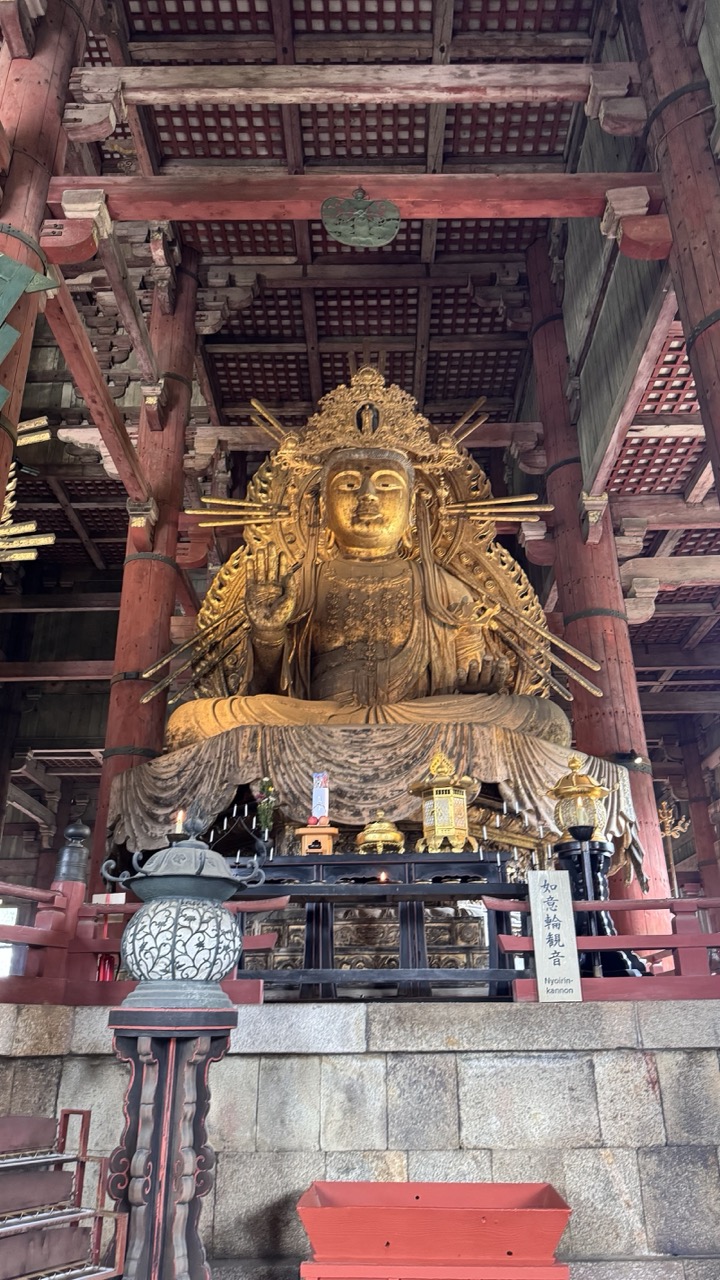

1. Overall Rating (0–10) — 8.0
This photograph captures the serene grandeur of a monumental golden Buddha statue within a traditional Japanese temple, evoking a sense of reverence and timelessness. The composition draws the eye directly to the figure, framed by the rich wooden architecture, while the interplay of light and shadow enhances the statue’s sacred presence. Though the foreground elements slightly disrupt the visual flow, the image succeeds in conveying both the spiritual weight and architectural beauty of the site.
2. Composition (0–10) — 7.5
The central placement of the Buddha creates a strong focal point, while the upward angle emphasizes the statue’s scale and dominance. The architectural lines of the ceiling and pillars converge toward the subject, enhancing depth and perspective. However, the cluttered lower frame—particularly the red container and ornate lantern—distracts from the overall harmony.
3. Lighting (0–10) — 7.0
Natural light filters softly through the temple structure, illuminating the golden surface of the statue with a warm, luminous glow. The interplay of light and shadow adds dimension to the face and drapery, while the shaded areas of the wooden ceiling create contrast without obscuring detail. The lighting feels authentic and respectful of the sacred space.
4. Color & Tone (0–10) — 8.0
The dominant gold of the statue contrasts beautifully with the deep reds of the timber and the muted gray of the stone base, creating a rich, harmonious palette. The tones are balanced and natural, enhancing the image’s spiritual atmosphere. The subtle variations in the wood’s patina and the stone’s texture add depth without overwhelming the composition.
5. Creativity (0–10) — 7.5
The image captures a moment of quiet devotion, blending architectural and spiritual elements with a sense of narrative. The choice to frame the statue from below elevates its presence, while the inclusion of cultural details like the lantern and sign adds contextual richness. While not overtly experimental, the approach is thoughtful and evocative.
6. Technical Quality (0–10) — 8.5
The photograph is sharp and clear, with fine detail visible in the statue’s intricate features and the surrounding woodwork. The exposure is well-balanced, preserving detail in both highlights and shadows. Focus is precise on the Buddha, while the background remains slightly softer, guiding attention effectively.
7. Emotional Impact (0–10) — 8.5
The image evokes a profound sense of peace, awe, and reverence. The scale of the statue, combined with the quiet stillness of the temple environment, invites contemplation and emotional connection. The viewer is drawn into a moment of spiritual stillness, making the photograph not just visually compelling, but deeply moving.
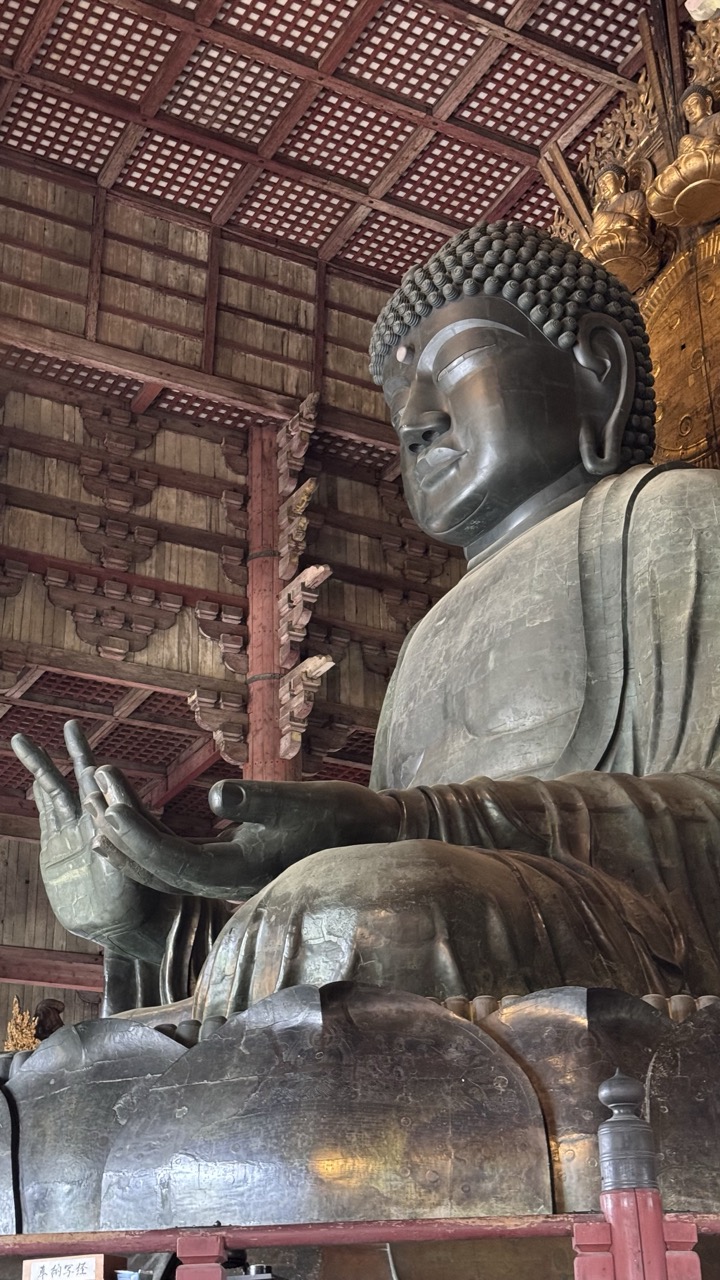

1. Overall Rating (0–10) — 8.0
This photograph captures the serene grandeur of the Great Buddha of Nara, conveying both spiritual reverence and architectural majesty. The low-angle perspective amplifies the statue’s imposing presence, while the interplay of light and shadow across its weathered surface adds a tactile depth. Though slightly underexposed in the lower regions, the image succeeds in evoking the quiet awe of standing before such a monumental cultural relic.
2. Composition (0–10) — 8.0
The diagonal placement of the Buddha’s body leads the eye naturally through the frame, while the intricate wooden ceiling and structural beams provide a rich architectural context. The framing effectively emphasizes scale and reverence, though a slightly tighter crop might enhance focus on the statue’s expression.
3. Lighting (0–10) — 7.5
The soft, diffused lighting highlights the contours of the Buddha’s face and hands, creating a contemplative mood. Subtle highlights on the bronze surface add dimension, while the dimmer areas beneath the statue contribute to a sense of depth and solemnity.
4. Color & Tone (0–10) — 7.0
The palette is dominated by the deep, earthy tones of aged bronze and warm wood, creating a harmonious and historically resonant atmosphere. The slight coolness in the bronze and the golden accents on the surrounding carvings offer subtle contrast, enhancing visual interest without disrupting the calm tone.
5. Creativity (0–10) — 7.5
The image transcends simple documentation by emphasizing both the physical and spiritual scale of the Buddha. The choice of angle and framing reflects a thoughtful interpretation of the subject, inviting contemplation rather than mere observation.
6. Technical Quality (0–10) — 8.0
The image is sharp and detailed, particularly in the texture of the bronze and the woodwork. Focus is well-managed, and the exposure, while slightly dark in the lower half, is consistent with the dim interior lighting of the temple.
7. Emotional Impact (0–10) — 8.5
There is a profound sense of stillness and reverence in the photograph, evoking a quiet emotional connection to the spiritual and cultural significance of the Buddha. The viewer is invited to feel the weight of history and devotion that the statue embodies.
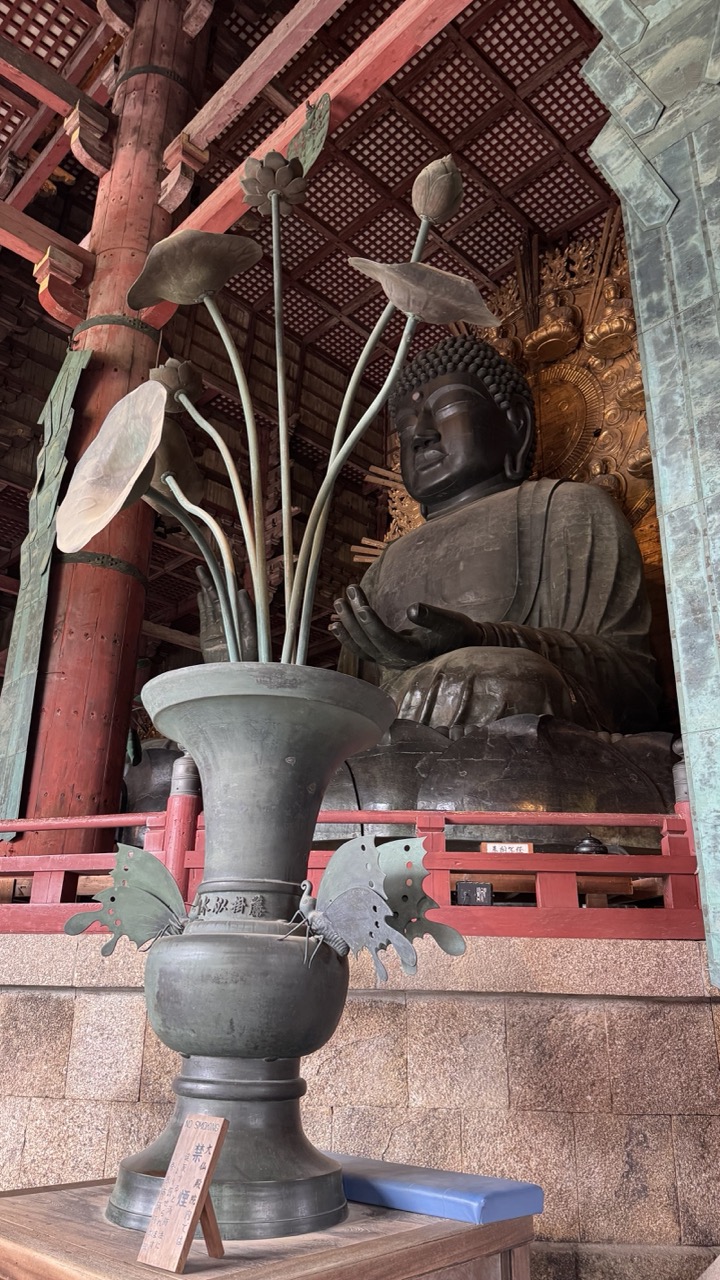

1. Overall Rating (0–10) — 7.5
This photograph captures the solemn grandeur of a sacred space, where the massive Buddha statue and the symbolic lotus arrangement converge in quiet reverence. The composition balances the imposing scale of the sculpture with the delicate detail of the metal lotus and butterflies, creating a sense of spiritual harmony. While the image effectively conveys the atmosphere of the temple, the slightly cluttered foreground and uneven lighting prevent it from achieving a more refined visual presence.
2. Composition (0–10) — 7.0
The foreground vase with lotus and butterfly motifs draws the eye, creating a layered depth that leads to the Buddha statue. However, the off-center placement of the vase and the intrusive red railing slightly disrupt the visual flow.
3. Lighting (0–10) — 6.5
Natural light filters through the temple’s structure, casting soft shadows that enhance the texture of the bronze and stone. The lighting is even but somewhat flat, lacking dramatic contrast to emphasize the Buddha’s serene expression.
4. Color & Tone (0–10) — 7.0
The palette is dominated by earthy tones—bronze, red, and muted stone—creating a cohesive and reverent atmosphere. The subtle green patina on the metal adds depth, while the red accents provide visual warmth without overpowering the scene.
5. Creativity (0–10) — 7.5
The juxtaposition of the traditional lotus sculpture with the monumental Buddha offers a layered narrative of faith and symbolism. The inclusion of the butterflies adds a poetic touch, suggesting transformation and impermanence.
6. Technical Quality (0–10) — 8.0
The image is sharp and well-focused, with clear details in the metalwork and the Buddha’s features. The depth of field is appropriate, and there are no visible technical flaws.
7. Emotional Impact (0–10) — 8.0
The photograph evokes a sense of peace and awe, inviting contemplation of the spiritual and cultural significance of the space. The quiet stillness of the scene resonates deeply, offering a moment of reflection to the viewer.
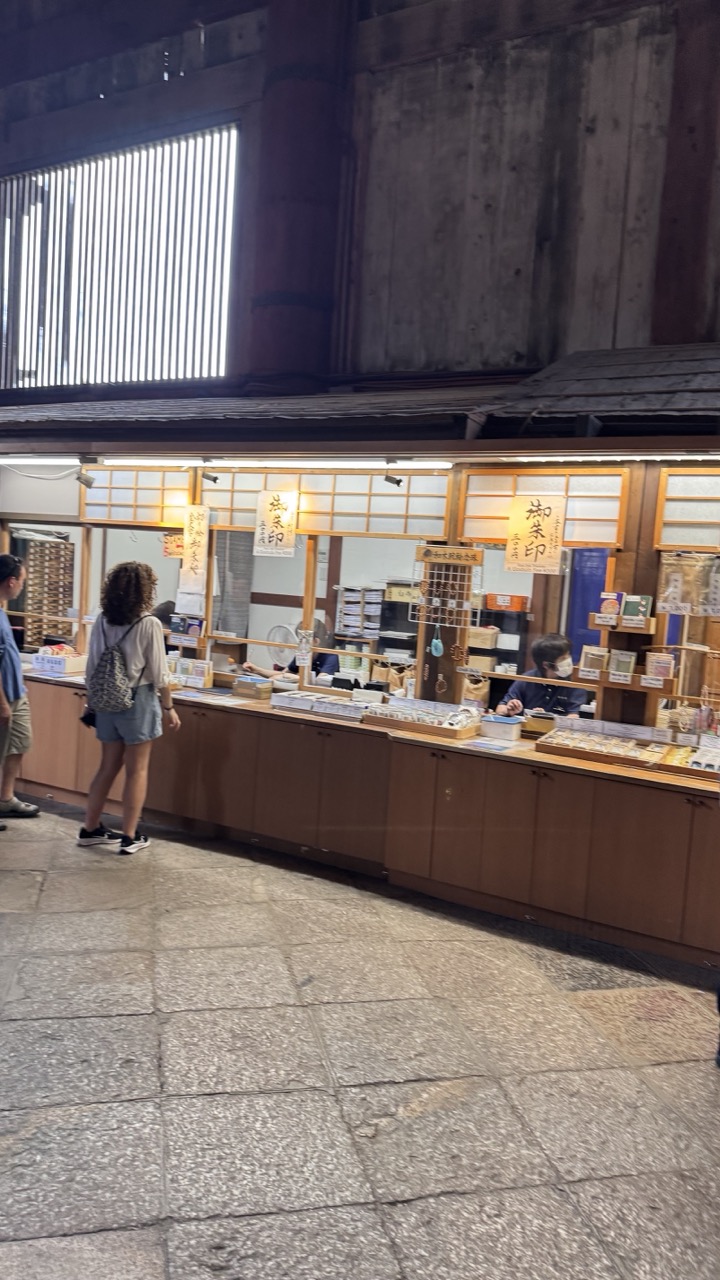

1. Overall Rating (0–10) — 5.8
This photograph captures the subdued atmosphere of a traditional Japanese shop at dusk, where warm interior light spills onto a stone-paved walkway. While the scene feels authentic and grounded in cultural detail, the flat lighting and slightly awkward framing reduce its visual impact. The image conveys a sense of quiet observation but lacks the dynamic energy or compositional clarity to feel fully compelling.
2. Composition (0–10) — 5.0
The wide-angle perspective introduces distortion and a cluttered foreground, while the subject is placed off-center, leading to a disjointed sense of balance. The low angle and tilted horizon further undermine compositional harmony.
3. Lighting (0–10) — 5.5
The contrast between the dim outdoor light and the warm, artificial glow inside the shop creates a modest sense of depth. However, the flat, unmodulated illumination inside and the underexposed foreground limit tonal range and mood.
4. Color & Tone (0–10) — 5.5
The palette is dominated by earthy browns and muted grays, with a slight yellow cast from the interior lights. While the colors feel natural, they lack vibrancy and visual cohesion, resulting in a somewhat flat and unengaging tonal quality.
5. Creativity (0–10) — 5.0
The image documents a moment with cultural authenticity, but it functions more as a snapshot than a creative interpretation. The lack of intentional framing or artistic manipulation limits its originality.
6. Technical Quality (0–10) — 6.0
The focus is reasonably sharp, and the image is free from major technical flaws like blur or noise. However, the wide-angle lens and camera angle introduce distortions that affect overall clarity.
7. Emotional Impact (0–10) — 5.0
The photograph evokes a quiet, contemplative mood, but the viewer is kept at a distance by the impersonal framing and lack of emotional focus. It suggests a moment in time but fails to elicit a strong emotional response.
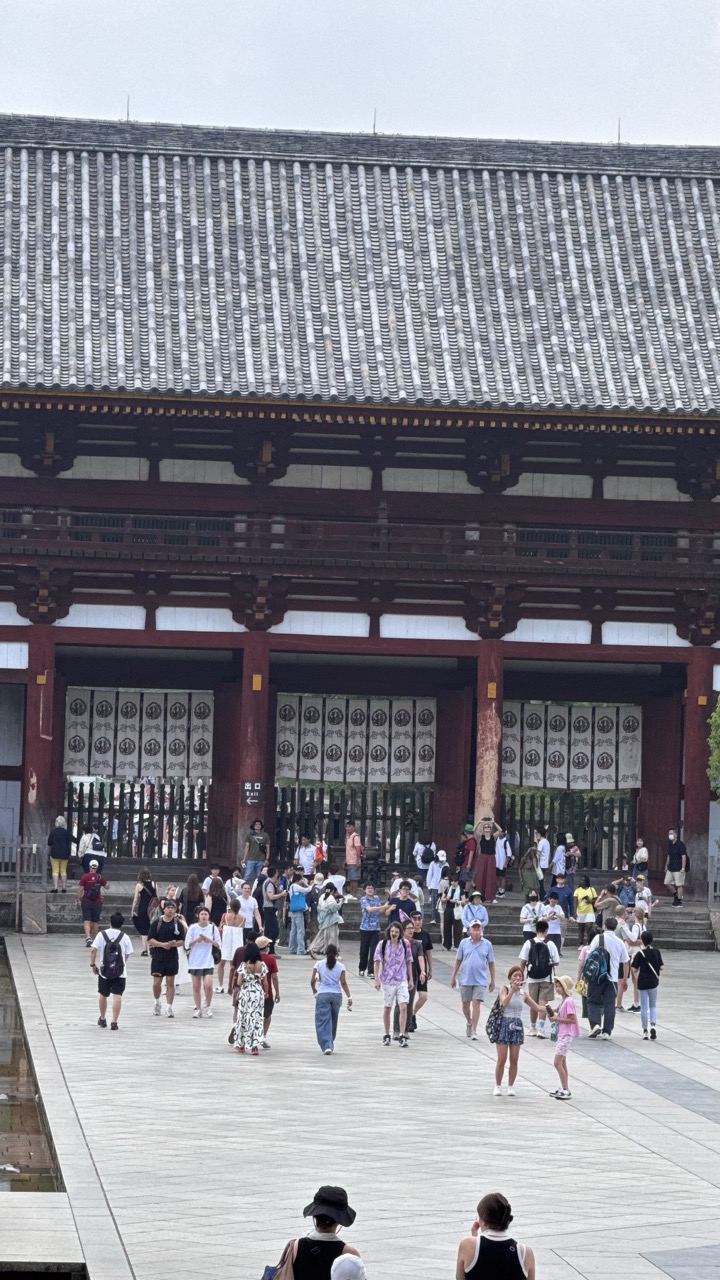

1. Overall Rating (0–10) — 6.0
This photograph captures the bustling energy of a traditional Japanese temple courtyard, where the grandeur of architecture meets the rhythm of daily life. The imposing tiled roof and red-lacquered pillars create a strong sense of cultural presence, while the crowd adds movement and scale. However, the overcast sky and flat lighting dull the scene’s potential drama, and the composition feels slightly crowded, with too much emphasis on the foreground to fully appreciate the temple’s majesty.
2. Composition (0–10) — 6.0
The wide-angle perspective captures both the temple and the crowd, but the low angle and busy foreground detract from the structure’s vertical dominance. The people, while adding life, disrupt the visual harmony and pull focus away from the architectural details.
3. Lighting (0–10) — 5.0
The overcast sky creates soft, even lighting that minimizes shadows and texture, resulting in a muted and somewhat lifeless atmosphere. While this prevents harsh contrasts, it also flattens the image’s depth and emotional resonance.
4. Color & Tone (0–10) — 5.5
The palette is dominated by neutral grays and earthy reds, with little vibrancy. The lack of dynamic contrast between the dark roof tiles and the pale sky reduces visual impact, and the colors appear washed out by the diffuse light.
5. Creativity (0–10) — 5.5
The image functions as a straightforward documentary record rather than a creative interpretation. While it successfully captures the scene’s scale and activity, it lacks a unique perspective or emotional narrative to elevate it beyond a generic travel snapshot.
6. Technical Quality (0–10) — 7.0
The focus is sharp across the frame, and the image is free of technical flaws such as blur or noise. The wide-angle lens is used effectively to include context, though it introduces some distortion at the edges.
7. Emotional Impact (0–10) — 5.0
The photograph conveys a sense of place and activity but fails to evoke a strong emotional response. The impersonal quality of the crowd and the lack of a clear focal point leave the viewer observing rather than feeling, reducing the image’s connective power.
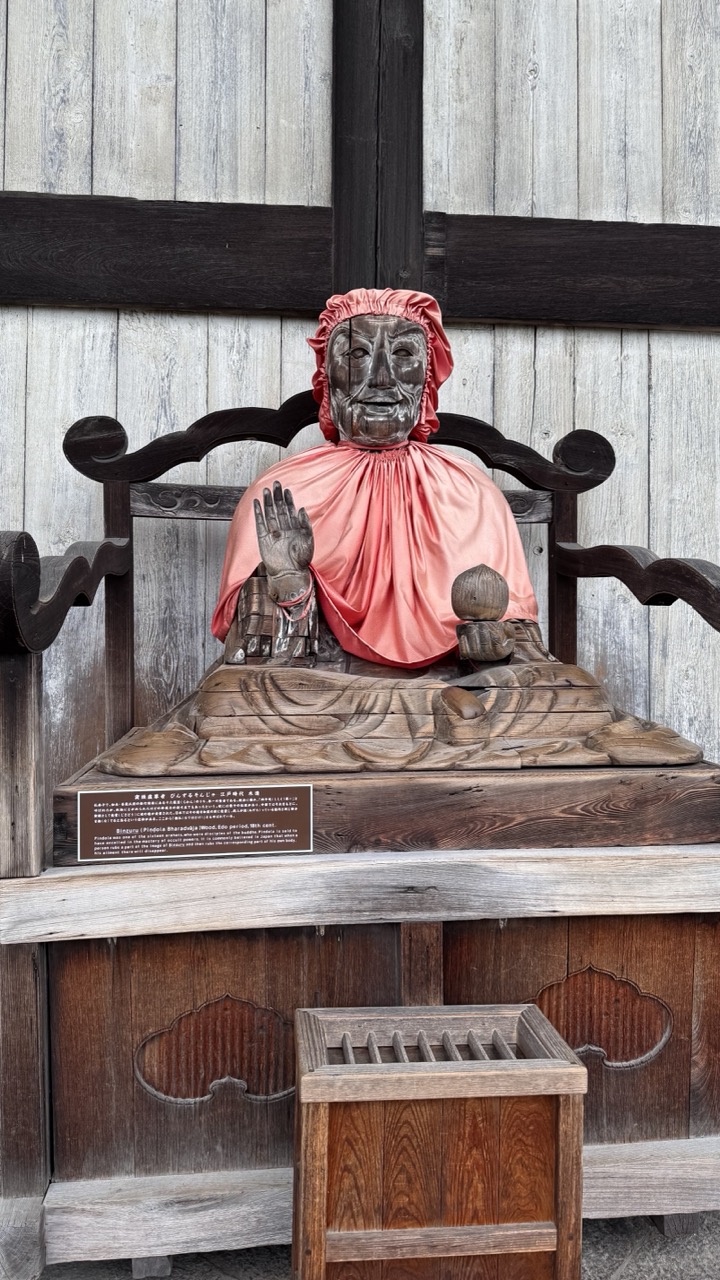

1. Overall Rating (0–10) — 7.0
This photograph captures the quiet dignity of a traditional Japanese wooden statue, its weathered face and vibrant pink cloth evoking both reverence and a subtle sense of mystery. The interplay of aged wood and the soft fabric creates a tactile contrast that draws the eye, while the composition grounds the subject in its cultural context. While the lighting is somewhat flat and the frame feels slightly cluttered, the image succeeds in conveying a meditative stillness and a quiet narrative of devotion.
2. Composition (0–10) — 7.0
The statue is centered and framed by the dark wooden chair and wall, creating a balanced, symmetrical composition that emphasizes its importance. The inclusion of the incense box in the foreground adds depth and cultural context without distracting from the main subject.
3. Lighting (0–10) — 5.5
The light is even and diffuse, likely natural daylight, which illuminates the scene clearly but lacks dramatic shadows or highlights. While this ensures visibility of details, it diminishes the atmospheric depth and emotional intensity that directional lighting could provide.
4. Color & Tone (0–10) — 7.0
The muted tones of the weathered wood contrast effectively with the bright pink fabric, creating a visually striking focal point. The color palette is restrained and harmonious, enhancing the image’s cultural authenticity and quiet mood.
5. Creativity (0–10) — 6.5
The image is observational rather than interpretive, capturing a moment of cultural presence without overt artistic manipulation. The choice to highlight the contrast between the aged wood and the vibrant cloth shows a subtle sense of storytelling, though it remains grounded in documentation.
6. Technical Quality (0–10) — 8.0
The image is sharp and well-focused, with fine detail visible in the wood grain, the statue’s features, and the fabric texture. The exposure is balanced, and there are no noticeable technical flaws.
7. Emotional Impact (0–10) — 6.5
The image evokes a sense of reverence and contemplation, inviting the viewer to reflect on tradition and devotion. The quiet presence of the statue and its sacred setting create a subtle emotional resonance, though the lack of dynamic lighting and personal narrative keeps the connection from feeling deeply intimate.
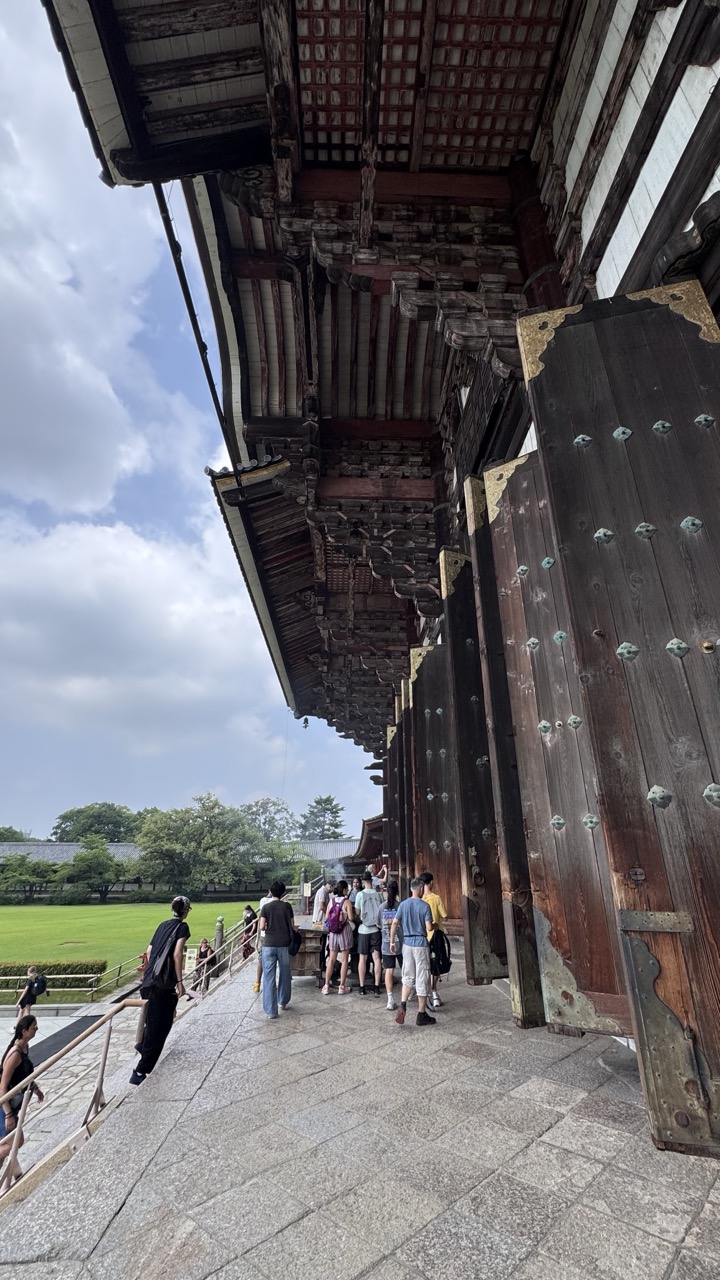

1. Overall Rating (0–10) — 7.0
This photograph captures the grandeur and intricate craftsmanship of a traditional Japanese temple gate, evoking a sense of reverence and historical depth. The low-angle perspective emphasizes the scale and architectural complexity of the structure, while the presence of visitors grounds the scene in lived experience. The image balances documentary realism with aesthetic weight, though the slightly cluttered foreground and casual framing temper its overall visual cohesion.
2. Composition (0–10) — 7.0
The low-angle view creates a dramatic sense of verticality and scale, drawing the eye upward along the layered eaves and wooden beams. The placement of the large wooden gate on the right and the line of visitors leading into the frame adds depth and guides the viewer’s movement through the space.
3. Lighting (0–10) — 6.5
Natural daylight illuminates the scene with soft, even light, allowing the textures of the weathered wood and stone to be clearly visible. The partly cloudy sky diffuses the light, reducing harsh shadows and contributing to a calm, contemplative mood.
4. Color & Tone (0–10) — 6.5
The palette is dominated by earthy browns and muted grays, punctuated by the green of the distant lawn and the subtle blue of the sky. The tonal range is balanced, though the overall color temperature leans neutral, slightly dampening the warmth of the wood and the vitality of the scene.
5. Creativity (0–10) — 7.0
The choice of a low-angle perspective and the inclusion of people within the frame transform a simple architectural shot into a narrative moment, inviting viewers to imagine stepping into the space. The juxtaposition of ancient craftsmanship and modern visitors adds layers of cultural continuity.
6. Technical Quality (0–10) — 7.5
The image is sharp and well-focused, particularly on the architectural details of the gate and roof. The resolution and clarity are strong, with clean detail in both the foreground and background, and minimal noise despite the natural lighting conditions.
7. Emotional Impact (0–10) — 6.5
The photograph conveys a quiet reverence for tradition and craftsmanship, with a subtle emotional pull from the presence of people engaging with the space. While the mood is respectful and contemplative, the lack of a stronger focal point or dramatic moment limits the depth of emotional resonance.
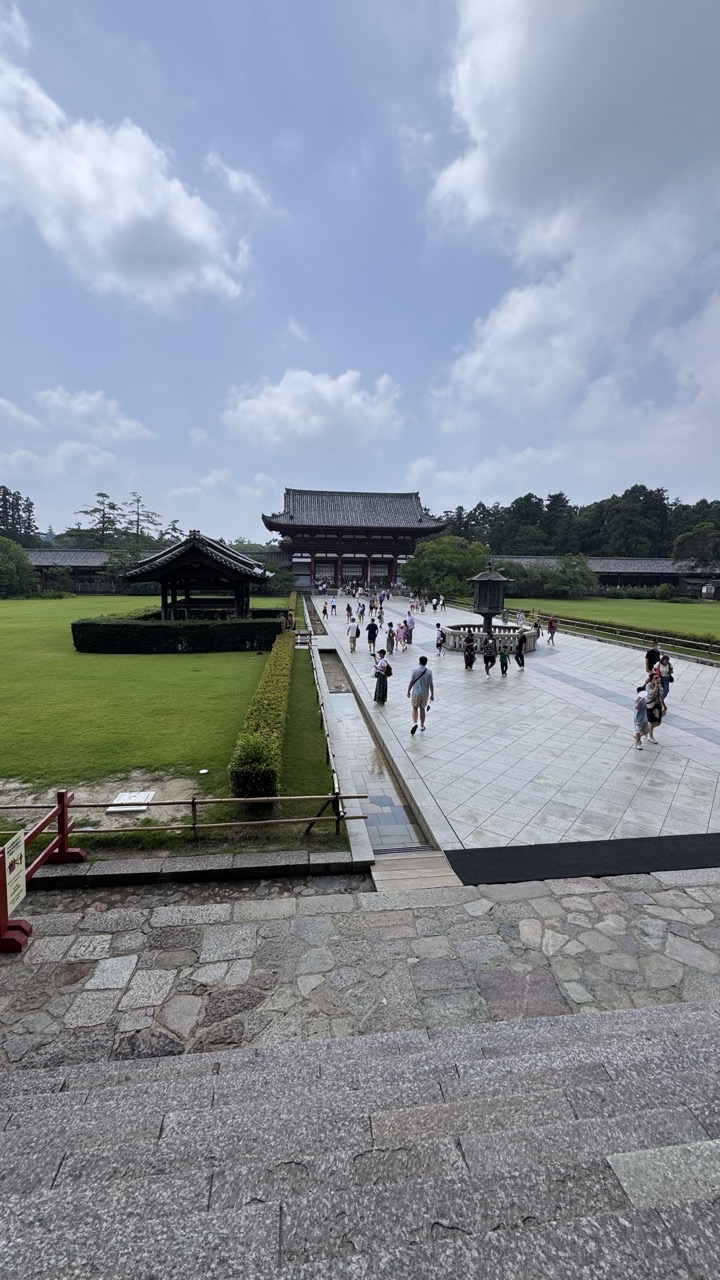

1. Overall Rating (0–10) — 7.0
This photograph captures the serene grandeur of a traditional Japanese temple complex, where architecture, landscape, and human presence coexist in quiet harmony. The wide perspective emphasizes the scale and symmetry of the space, drawing the eye toward the central gate under a vast, cloud-dappled sky. While the composition is strong, the presence of tourists slightly disrupts the spiritual stillness often associated with such sites, grounding the image in the reality of contemporary tourism.
2. Composition (0–10) — 7.5
The diagonal line of the stone pathway and the central alignment of the gate create a strong sense of depth and direction. The framing from the elevated steps adds perspective, while the balance between the manicured lawn and the open plaza maintains visual equilibrium.
3. Lighting (0–10) — 7.0
Natural daylight provides even illumination, with soft shadows indicating a partly cloudy day. The sky’s dynamic clouds add texture and mood, enhancing the atmosphere without overpowering the scene.
4. Color & Tone (0–10) — 6.5
The palette is dominated by natural greens and grays, lending a calm, grounded tone. The muted earth tones of the stone and wood harmonize well, though the lack of vibrant contrast slightly reduces visual energy.
5. Creativity (0–10) — 6.0
The image functions more as a documentary record than a conceptual statement, capturing a moment in time with clarity and respect for the site. While not highly original in approach, it effectively communicates the dignity of the location.
6. Technical Quality (0–10) — 8.0
The image is sharp and well-focused, with clean detail in both the foreground stone and the distant architecture. The exposure is balanced, preserving detail in both the bright sky and shaded areas.
7. Emotional Impact (0–10) — 6.5
The photograph evokes a sense of peaceful contemplation and reverence, though the presence of visitors tempers the meditative quality. It invites the viewer to reflect on the intersection of tradition and modern life.
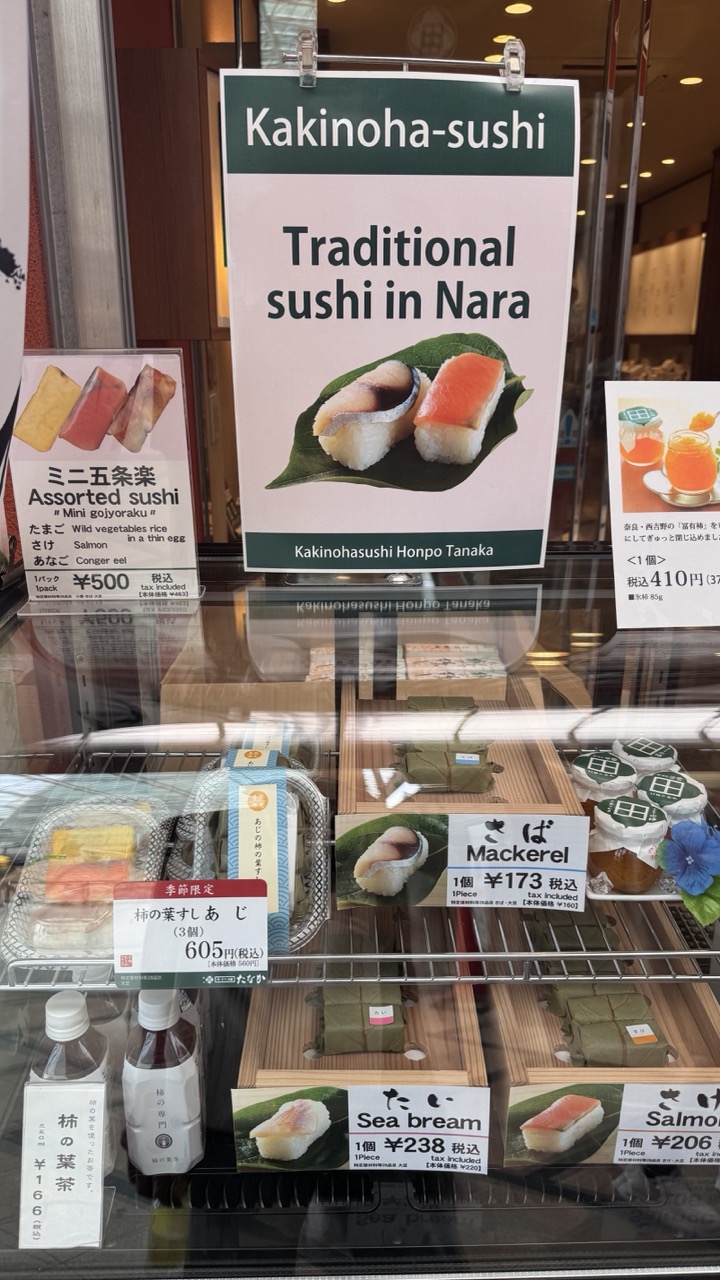

1. Overall Rating (0–10) — 6.0
This image captures the essence of a traditional Japanese sushi shop with a focus on accessibility and cultural authenticity. The layered signage and neatly arranged products create a sense of organized abundance, while the transparent display allows the viewer to peer into the daily rhythm of a local eatery. However, the composition feels slightly cluttered and lacks a strong focal point, reducing its visual cohesion and emotional pull.
2. Composition (0–10) — 5.5
The framing is functional but busy, with multiple signs and product labels competing for attention. The central poster serves as a visual anchor, yet the overlapping elements create a sense of visual noise, weakening the overall balance.
3. Lighting (0–10) — 6.0
The lighting is bright and even, likely from overhead fluorescent fixtures, which clearly illuminates the products but lacks warmth or atmospheric depth. It feels utilitarian, appropriate for a retail display but not particularly evocative.
4. Color & Tone (0–10) — 6.5
The palette is dominated by soft whites, greens, and browns, creating a natural, food-focused aesthetic. The green signage and leaf accents reinforce the theme of freshness, though the colors are slightly muted, giving the scene a neutral, almost sterile quality.
5. Creativity (0–10) — 5.5
The image is more documentary than artistic, capturing a real-world scene with little stylistic intervention. While the subject matter—traditional sushi in Nara—is inherently engaging, the presentation feels straightforward and unremarkable in terms of creative interpretation.
6. Technical Quality (0–10) — 7.5
The image is sharp and well-focused, with clear text and clean details visible on the packaging and signs. The reflections on the glass are minor and do not significantly detract from the clarity of the content.
7. Emotional Impact (0–10) — 5.0
The photo conveys a sense of everyday life and local culture, but its clinical presentation limits emotional resonance. It invites curiosity about the food and place but doesn’t evoke deeper feelings of nostalgia or wonder.


1. Overall Rating (0–10) — 5.5
This photograph captures a moment of everyday dining culture, presenting a menu card from a Japanese restaurant with a quiet, observational charm. The composition, though candid, is cluttered and slightly awkward, with overlapping elements that distract from the central subject. While the image successfully conveys the texture and atmosphere of a real-life dining experience—complete with a hand, a wooden table, and layered paper—it lacks the visual clarity and intentional framing that would elevate it into a compelling portrait of food and place.
2. Composition (0–10) — 5.0
The framing is loose and unbalanced, with the menu card tilted and partially obscured by the hand and other papers. The depth of field is shallow, but the focus on the central image of the food set is not sharp enough to anchor the viewer’s attention. The overlapping layers create visual noise, weakening the overall cohesion.
3. Lighting (0–10) — 5.5
The lighting appears to be ambient indoor light, likely from overhead fixtures, resulting in a flat and slightly dim exposure. While adequate for reading the text, it fails to create mood or highlight the textures of the food or wood grain, giving the image a functional but unremarkable quality.
4. Color & Tone (0–10) — 5.5
The color palette is muted, dominated by earthy browns and soft pastels, which reflect the natural tones of the menu and wood. The color temperature is neutral, with a slight yellow cast that suggests artificial lighting. While the colors are harmonious, they lack vibrancy and contrast, contributing to a somewhat dull visual impression.
5. Creativity (0–10) — 5.0
The photograph is a straightforward documentation of a menu, with little artistic intent beyond capturing the moment. The inclusion of the hand and surrounding clutter adds a layer of authenticity, but the lack of intentional composition or narrative focus limits its creative impact.
6. Technical Quality (0–10) — 6.0
The image is reasonably sharp on the central subject, though slightly soft due to focus and lighting conditions. The depth of field is adequate, but the overall clarity is compromised by the angle and the presence of glare on the paper surface. There are no significant technical flaws, but the execution feels more like a snapshot than a deliberate photograph.
7. Emotional Impact (0–10) — 5.0
The image evokes a mild sense of familiarity and nostalgia, particularly for those familiar with Japanese dining culture. However, the emotional resonance is limited by the lack of focus and the impersonal, cluttered presentation. It feels more like a memory captured than an experience shared, leaving the viewer with a sense of quiet observation rather than deep connection.
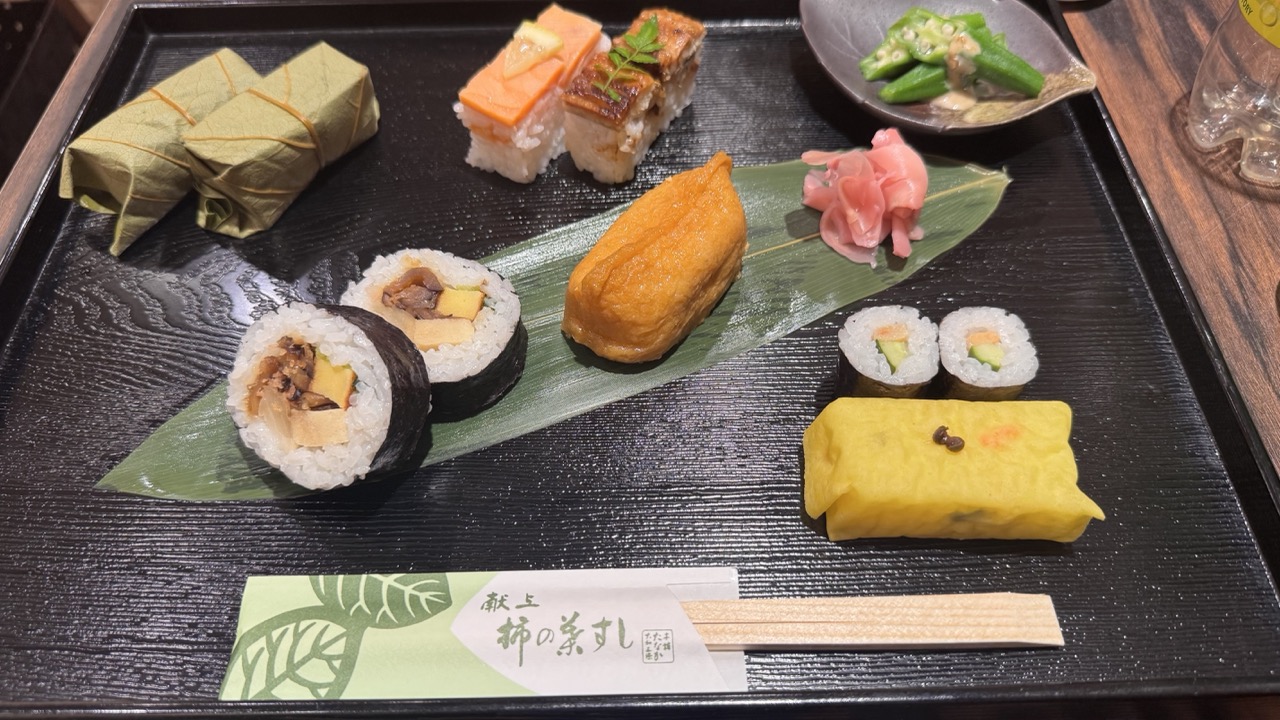

1. Overall Rating (0–10) — 7.5
This photograph captures a refined Japanese sushi platter with a quiet elegance, where each element is carefully arranged to reflect tradition and craftsmanship. The dark tray provides a strong contrast to the vibrant colors of the food, while the inclusion of natural textures like the leaf and bamboo chopsticks enhances the organic feel. Though the composition is visually rich, a more deliberate arrangement could elevate the image from a simple documentation to a compelling still-life.
2. Composition (0–10) — 7.0
The placement of the sushi pieces and garnishes creates a balanced diagonal flow across the tray, drawing the eye from the wrapped items on the left to the small side dish on the right. The large green leaf acts as a natural divider, enhancing visual rhythm. However, the chopsticks and paper in the foreground slightly disrupt the visual harmony, pulling focus away from the main subject.
3. Lighting (0–10) — 7.5
Soft, ambient lighting enhances the textures of the food without creating harsh shadows, giving the scene a warm and inviting glow. The gentle reflections on the tray add depth, while the highlights on the pickled ginger and tamagoyaki emphasize their freshness. The lighting supports the mood of a refined dining experience.
4. Color & Tone (0–10) — 8.0
The palette is harmonious, with the deep black of the tray providing a dramatic backdrop for the bright orange of the tamagoyaki, the pink of the ginger, and the green of the leaf and okra. The subtle use of warm tones adds a sense of authenticity and appetite appeal, while the contrast between the dark background and vibrant food creates visual excitement.
5. Creativity (0–10) — 7.0
The image is rooted in tradition, showcasing a classic Japanese meal with attention to detail. While the arrangement is aesthetically pleasing, it follows a familiar format—there is little conceptual risk or narrative innovation. The creativity lies more in the execution than in the vision.
6. Technical Quality (0–10) — 8.5
Sharp focus across the frame ensures clarity in the textures of the rice, nori, and various toppings. The depth of field is well-managed, keeping the main elements in focus while softly blurring the background. The image is clean, with no noticeable noise or distortion.
7. Emotional Impact (0–10) — 7.5
The photograph evokes a sense of calm and appreciation for culinary artistry. The careful presentation and warm lighting invite the viewer to savor the moment, suggesting a quiet, mindful meal. There’s a subtle emotional resonance in the attention to detail, hinting at the care behind the food’s preparation.
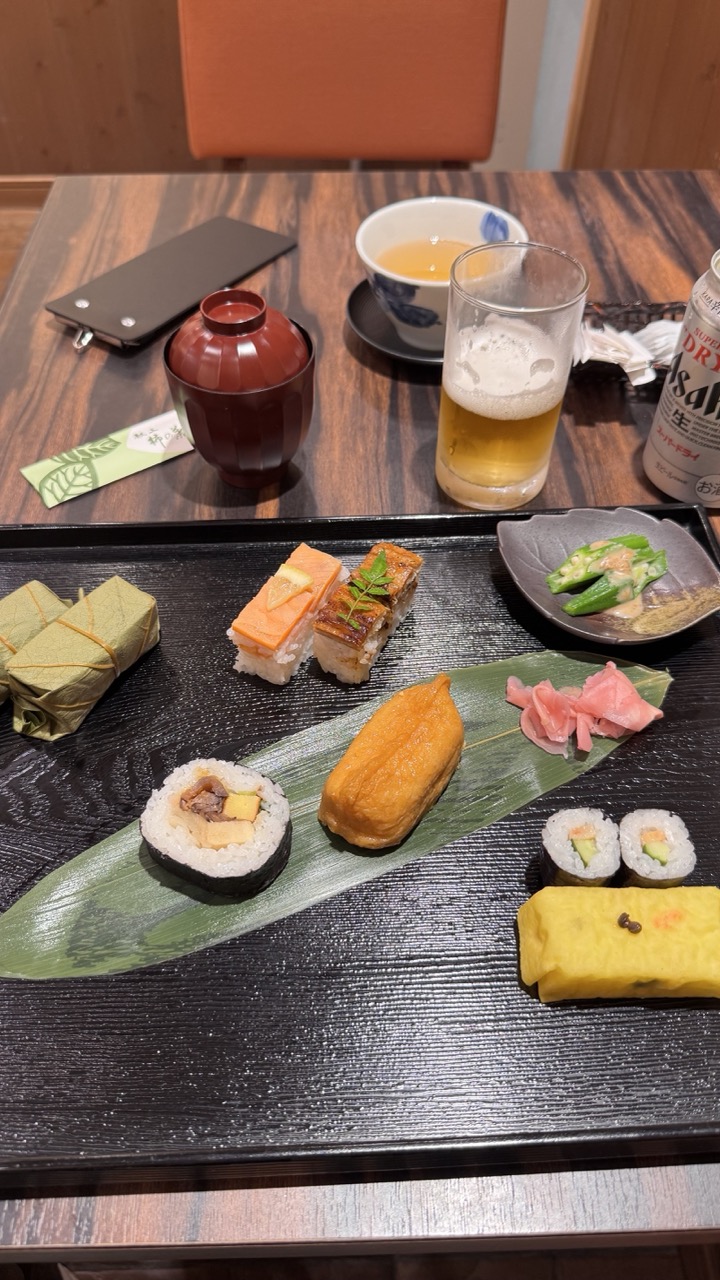

1. Overall Rating (0–10) — 7.0
This photograph captures a serene and inviting Japanese meal, rich in cultural detail and culinary texture. The arrangement of sushi, tempura, and tea evokes a sense of mindful dining, enhanced by the warm wooden tones and natural materials. While the composition is visually engaging, the slightly cluttered background and uneven lighting detract from the image’s overall refinement, keeping it from feeling fully polished.
2. Composition (0–10) — 6.5
The placement of the sushi platter is balanced, with the green leaf and side dishes guiding the eye across the frame. However, the scattered objects—especially the phone and can—create visual distractions that disrupt the harmony.
3. Lighting (0–10) — 6.0
The lighting is warm and ambient, likely from overhead fixtures, which enhances the cozy atmosphere. However, there are slight shadows and uneven exposure, particularly in the upper half of the image, reducing clarity.
4. Color & Tone (0–10) — 7.0
The palette is harmonious, with earthy browns, soft greens, and pops of orange and pink creating a natural, appetizing look. The contrast between the dark tray and light-colored food enhances visual appeal.
5. Creativity (0–10) — 7.5
The image successfully blends everyday dining with a sense of ritual, capturing a moment of quiet indulgence. The inclusion of traditional elements like the chawan and leaf-wrapped items adds authenticity and narrative depth.
6. Technical Quality (0–10) — 7.5
The image is sharp and clear, with good focus on the main subject. The depth of field is appropriate, keeping the food in crisp detail while softly blurring the background.
7. Emotional Impact (0–10) — 7.0
There’s a quiet intimacy in the scene—comfort, warmth, and the pleasure of a well-prepared meal. It invites the viewer to pause and savor the moment, even if from a distance.
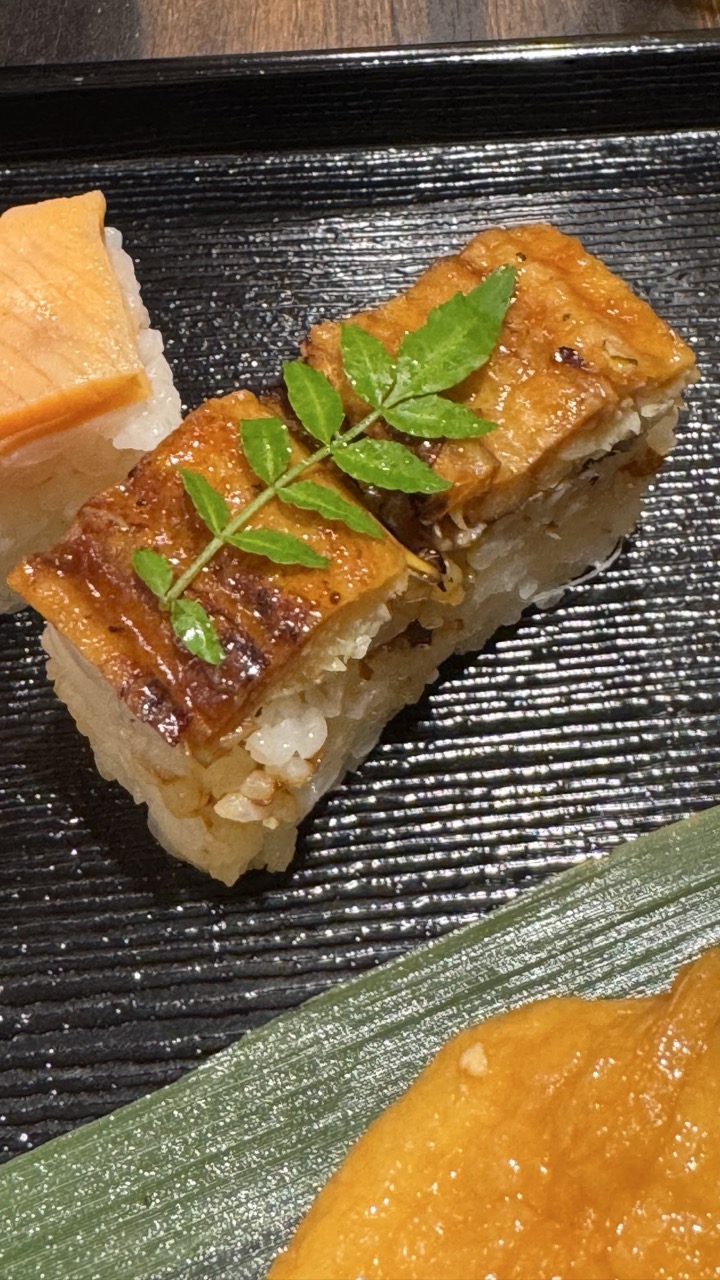

1. Overall Rating (0–10) — 7.5
This photograph captures the artistry of Japanese cuisine with a focus on texture and flavor, where the glistening grilled eel and delicate green garnish draw the eye. The composition balances detail and context, presenting the sushi as both a culinary object and a cultural artifact. While the image excels in showcasing food’s sensory appeal, its slightly cluttered framing and subdued lighting prevent it from achieving a more refined aesthetic.
2. Composition (0–10) — 7.0
The diagonal placement of the sushi and the leaf creates a dynamic flow, guiding the eye across the frame. However, the inclusion of the partially cropped green leaf in the foreground slightly disrupts balance and reduces focus on the main subject.
3. Lighting (0–10) — 6.5
Soft, directional lighting highlights the glistening surface of the eel and the texture of the rice, but the shadows are somewhat harsh and uneven, creating a mix of bright highlights and dark areas that distract from the overall harmony.
4. Color & Tone (0–10) — 7.5
The warm amber of the grilled eel contrasts beautifully with the dark, textured plate and the vibrant green of the garnish. The tonal range is rich, though the overall color temperature leans slightly cool, muting the warmth of the food.
5. Creativity (0–10) — 8.0
The image conveys a sense of authenticity and craftsmanship, with the carefully placed garnish and attention to detail suggesting intentionality. The use of the leaf as a framing element adds a natural, organic touch that enhances the cultural context.
6. Technical Quality (0–10) — 8.0
The focus is sharp on the main subject, with clear detail in the rice grains and the texture of the eel. The depth of field is appropriate, though minor noise is visible in the darker areas of the plate.
7. Emotional Impact (0–10) — 7.0
The photograph evokes a sense of quiet appreciation for traditional food preparation, inviting the viewer to imagine the taste and aroma. While it doesn’t elicit strong emotion, it successfully communicates a moment of culinary refinement.
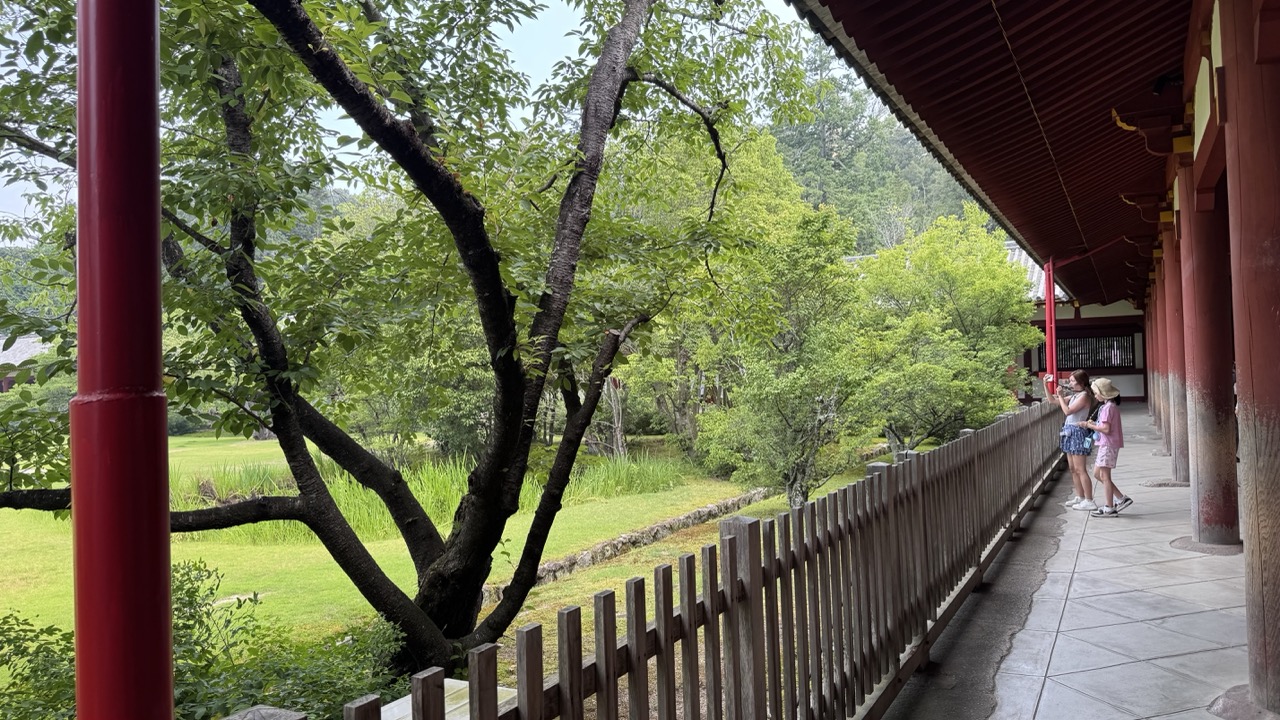

1. Overall Rating (0–10) — 7.0
This photograph captures a serene moment within a traditional Japanese garden, where the interplay of architecture and nature evokes a sense of calm and timelessness. The red pillars and wooden railing frame the scene with cultural authenticity, while the lush greenery and quiet stroll of visitors lend a contemplative, almost meditative quality. While the image is rich in atmosphere, it lacks a strong focal point, making the composition feel slightly passive and observational rather than compelling.
2. Composition (0–10) — 6.5
The strong diagonal line of the walkway and railing leads the eye into the frame, creating a sense of depth. However, the large red pillar on the left dominates the left side, slightly unbalancing the composition. The two figures in the distance are small and understated, reducing their visual impact and making the scene feel more like a snapshot than a carefully constructed image.
3. Lighting (0–10) — 6.0
The soft, diffused light of an overcast day evenly illuminates the scene, minimizing harsh shadows and preserving detail in both the foliage and the architectural elements. While this creates a peaceful mood, it also results in a somewhat flat and muted atmosphere, with little contrast to draw attention to specific areas.
4. Color & Tone (0–10) — 7.0
The palette is harmonious, with the deep red of the pillars providing a striking contrast to the vibrant greens of the trees and grass. The neutral tones of the wooden fence and stone path help anchor the image, while the overall cool color temperature reinforces the tranquil, slightly melancholic mood. The colors feel natural and authentic, though they lack vibrancy.
5. Creativity (0–10) — 6.5
The image succeeds in capturing a quiet, everyday moment within a culturally rich environment, offering a subtle narrative about travel, reflection, and connection to nature. The framing suggests a personal perspective—perhaps from a traveler’s point of view—but the lack of a strong visual hook limits its originality and artistic boldness.
6. Technical Quality (0–10) — 7.5
The photograph is sharp and well-focused, with clear detail in the textures of the wood, stone, and foliage. The exposure is balanced, and there are no noticeable technical flaws such as motion blur or noise. The camera appears to have captured the scene with precision, though the framing and subject placement could have been more intentional.
7. Emotional Impact (0–10) — 6.5
The image evokes a sense of peace and quiet contemplation, inviting the viewer to imagine themselves walking along the path and absorbing the stillness of the garden. The presence of people adds a human touch, grounding the scene in reality, but their small scale and lack of emotional expression keep the emotional connection from deepening.


1. Overall Rating (0–10) — 7.0
This photograph captures the serene grandeur of a traditional Japanese temple complex, where architecture, landscape, and human presence coexist in quiet harmony. The wide perspective emphasizes the scale and symmetry of the space, drawing the eye toward the central gate under a vast, cloud-dappled sky. While the composition is strong, the presence of tourists slightly disrupts the spiritual stillness often associated with such sites, grounding the image in the reality of contemporary tourism.
2. Composition (0–10) — 7.5
The diagonal line of the stone pathway and the central alignment of the gate create a strong sense of depth and direction. The framing from the elevated steps adds perspective, while the balance between the manicured lawn and the open plaza maintains visual equilibrium.
3. Lighting (0–10) — 7.0
Natural daylight provides even illumination, with soft shadows indicating a partly cloudy day. The sky’s dynamic clouds add texture and mood, enhancing the atmosphere without overpowering the scene.
4. Color & Tone (0–10) — 6.5
The palette is dominated by natural greens and grays, lending a calm, grounded tone. The muted earth tones of the stone and wood harmonize well, though the lack of vibrant contrast slightly reduces visual energy.
5. Creativity (0–10) — 6.0
The image functions more as a documentary record than a conceptual statement, capturing a moment in time with clarity and respect for the site. While not highly original in approach, it effectively communicates the dignity of the location.
6. Technical Quality (0–10) — 8.0
The image is sharp and well-focused, with clean detail in both the foreground stone and the distant architecture. The exposure is balanced, preserving detail in both the bright sky and shaded areas.
7. Emotional Impact (0–10) — 6.5
The photograph evokes a sense of peaceful contemplation and reverence, though the presence of visitors tempers the meditative quality. It invites the viewer to reflect on the intersection of tradition and modern life.
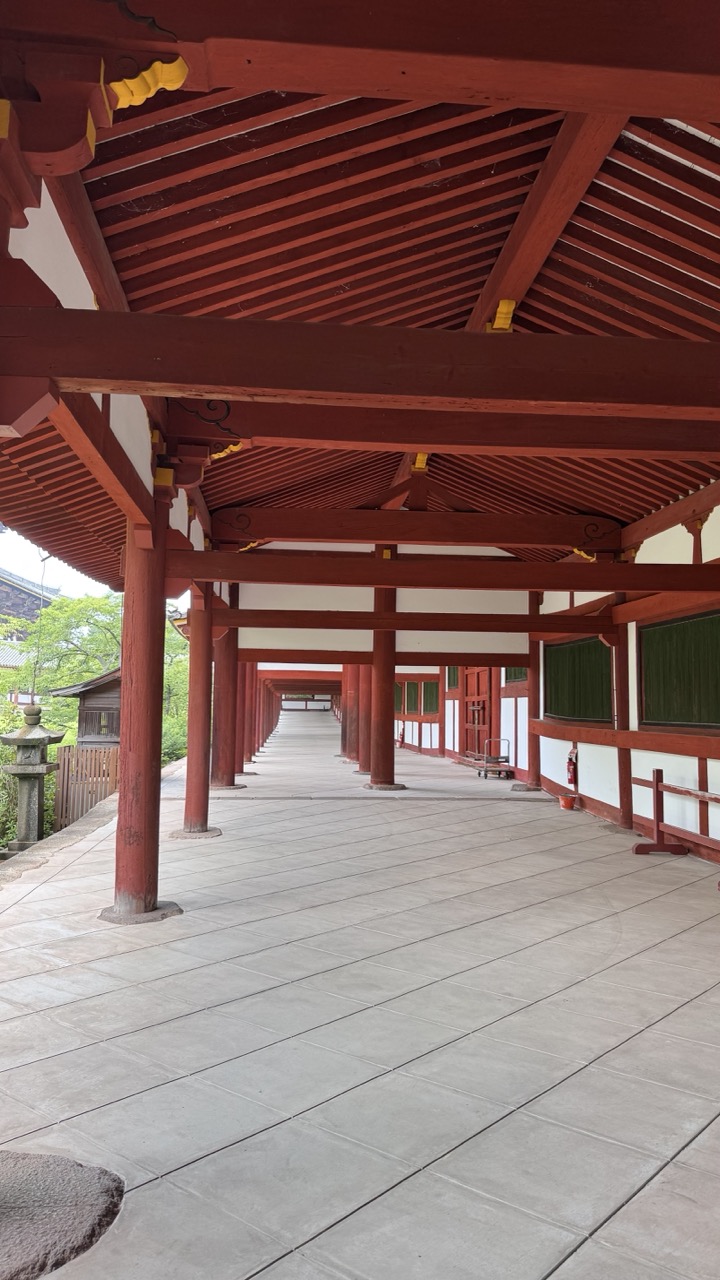

1. Overall Rating (0–10) — 7.0
This photograph captures the serene rhythm of a traditional Japanese temple corridor, where architecture and space harmonize in quiet elegance. The strong linear perspective draws the eye into the distance, emphasizing both depth and stillness, while the warm red wood and cool stone create a balanced, meditative atmosphere. Though the scene is inherently peaceful, the composition's simplicity and lack of human presence slightly diminish its emotional immediacy.
2. Composition (0–10) — 8.0
The strong leading lines of the roof and pillars create a powerful sense of depth and symmetry, guiding the viewer’s gaze through the corridor. The low angle enhances the architectural grandeur, while the slight asymmetry on the left adds subtle visual interest without disrupting the balance.
3. Lighting (0–10) — 6.5
Soft, diffused daylight evenly illuminates the scene, minimizing harsh shadows and allowing the textures of wood and stone to emerge naturally. The light enhances the calm mood but lacks directional drama, resulting in a somewhat flat and neutral illumination.
4. Color & Tone (0–10) — 7.0
The rich reds of the wooden structure contrast beautifully with the muted gray stone and green foliage, creating a traditional and harmonious palette. The tones are balanced and subdued, reinforcing the tranquil atmosphere without appearing overly stylized.
5. Creativity (0–10) — 6.5
The image leverages strong architectural lines and symmetry to create a compelling visual narrative, but its approach is more documentary than interpretive. The subject matter is inherently evocative, yet the photograph remains largely observational rather than artistically inventive.
6. Technical Quality (0–10) — 8.0
Sharp focus and clean detail throughout the frame highlight the textures of the wood and stone. The exposure is well-managed, with no blown-out highlights or crushed shadows, contributing to a technically polished result.
7. Emotional Impact (0–10) — 6.0
The image evokes a sense of quiet contemplation and timelessness, drawing the viewer into a moment of stillness. However, the absence of people or movement keeps the emotional resonance at a distance, making it more of a visual document than an intimate experience.
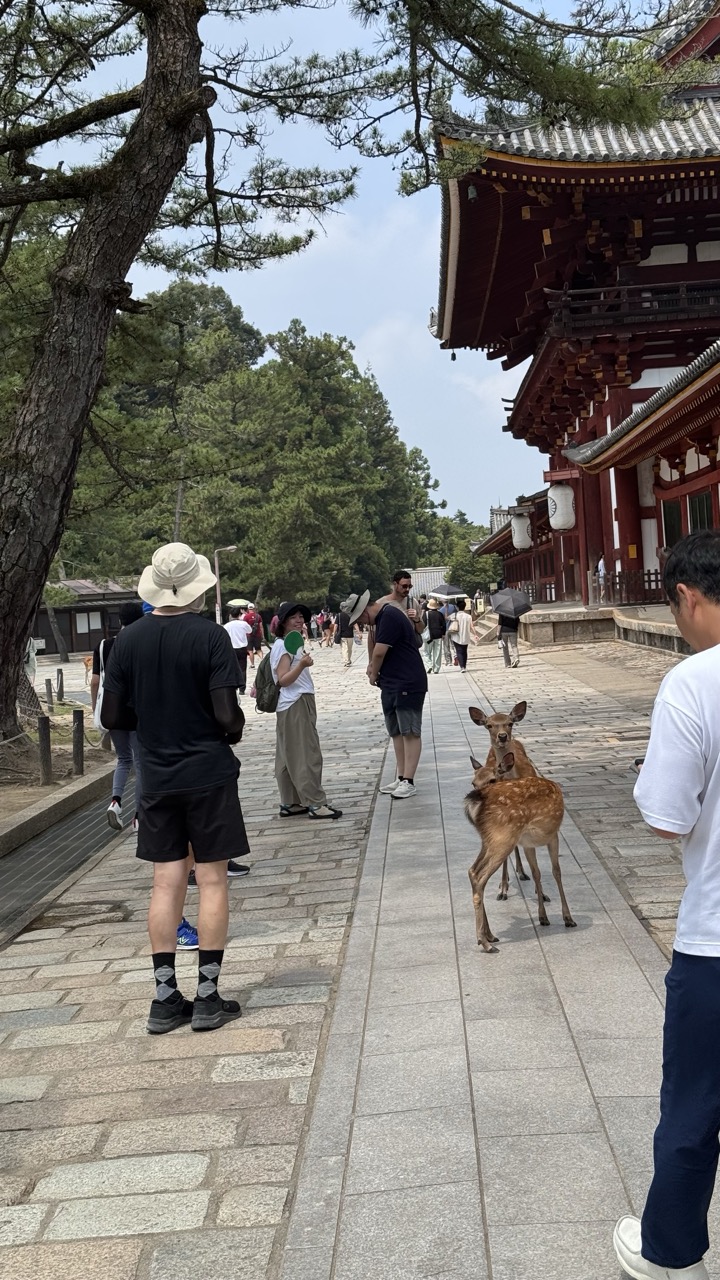

1. Overall Rating (0–10) — 6.0
This photograph captures a candid moment at a historic Japanese temple, where tradition and tourism intersect in a quiet, everyday scene. The presence of deer and visitors creates a sense of cultural familiarity, yet the image feels more like a snapshot than a composed portrait—lacking a strong focal point and emotional pull. While it documents a real experience with authenticity, it struggles to elevate the ordinary into something visually compelling.
2. Composition (0–10) — 5.5
The diagonal line of the pathway guides the eye through the frame, but the crowded foreground and uneven subject placement create visual clutter. The deer, though central, are framed by too many people, diluting their symbolic presence.
3. Lighting (0–10) — 6.0
Natural daylight provides even illumination, though the overcast sky softens shadows and reduces depth. The light is functional but unremarkable, failing to enhance the scene’s atmosphere or highlight architectural details.
4. Color & Tone (0–10) — 6.5
The palette is grounded in natural tones—earthy browns, muted greens, and soft grays—creating a cohesive, realistic look. A slight coolness in the white balance tempers the warmth of the temple’s red wood, but the colors are harmonious and well-balanced.
5. Creativity (0–10) — 6.0
The image captures a unique cultural interaction between people and deer in Nara, but it relies on the scene’s inherent charm rather than artistic interpretation. The moment is authentic, yet it doesn’t push beyond documentary to evoke deeper meaning.
6. Technical Quality (0–10) — 7.5
The image is sharp and well-focused, with clear detail in the textures of the stone path, tree bark, and temple architecture. The exposure is balanced, with no harsh highlights or crushed shadows.
7. Emotional Impact (0–10) — 5.5
While the scene suggests peace and coexistence, the emotional resonance is muted by the lack of narrative focus and the impersonal framing. The viewer is invited to observe, but not to feel.
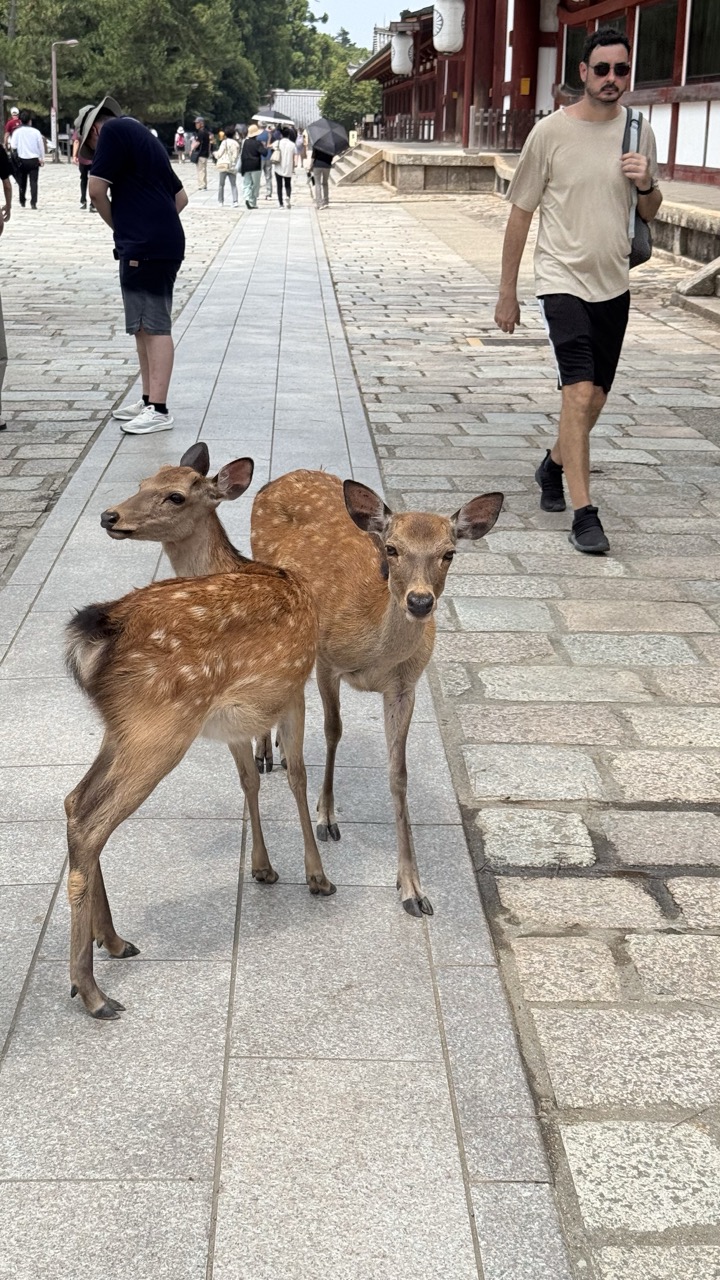

1. Overall Rating (0–10) — 6.0
This photograph captures a candid moment of harmony between nature and human activity at a cultural site, where deer stroll freely among visitors. The juxtaposition of the calm, inquisitive deer and the casual tourists creates a sense of everyday serenity, though the composition feels slightly cluttered and lacks a strong focal point. While the scene is charming and authentic, it falls short of visual storytelling, feeling more like a snapshot than a polished image.
2. Composition (0–10) — 5.5
The two deer are well-placed in the foreground, drawing attention, but the busy background and diagonal lines of the walkway create visual tension. A tighter crop would enhance focus on the subjects.
3. Lighting (0–10) — 6.0
Natural daylight provides even illumination with soft shadows, highlighting the texture of the deer’s fur and the stone pavement. The overcast sky prevents harsh contrasts, contributing to a calm, neutral mood.
4. Color & Tone (0–10) — 6.5
The palette is composed of earthy browns, muted grays, and soft beige tones, which complement the natural setting. While not vibrant, the colors are cohesive and enhance the scene’s tranquil atmosphere.
5. Creativity (0–10) — 6.0
The image captures a unique cultural moment—deer interacting with people at a historic site—but the approach is conventional. A more deliberate perspective or timing could have elevated the narrative.
6. Technical Quality (0–10) — 7.0
The image is sharp and clear, with good detail in the deer and surroundings. Focus is well-managed, though slight noise is present in the background.
7. Emotional Impact (0–10) — 5.5
The scene evokes a sense of peace and curiosity, particularly through the deer’s direct gaze. However, the lack of strong emotional tension or human connection limits its resonance with the viewer.
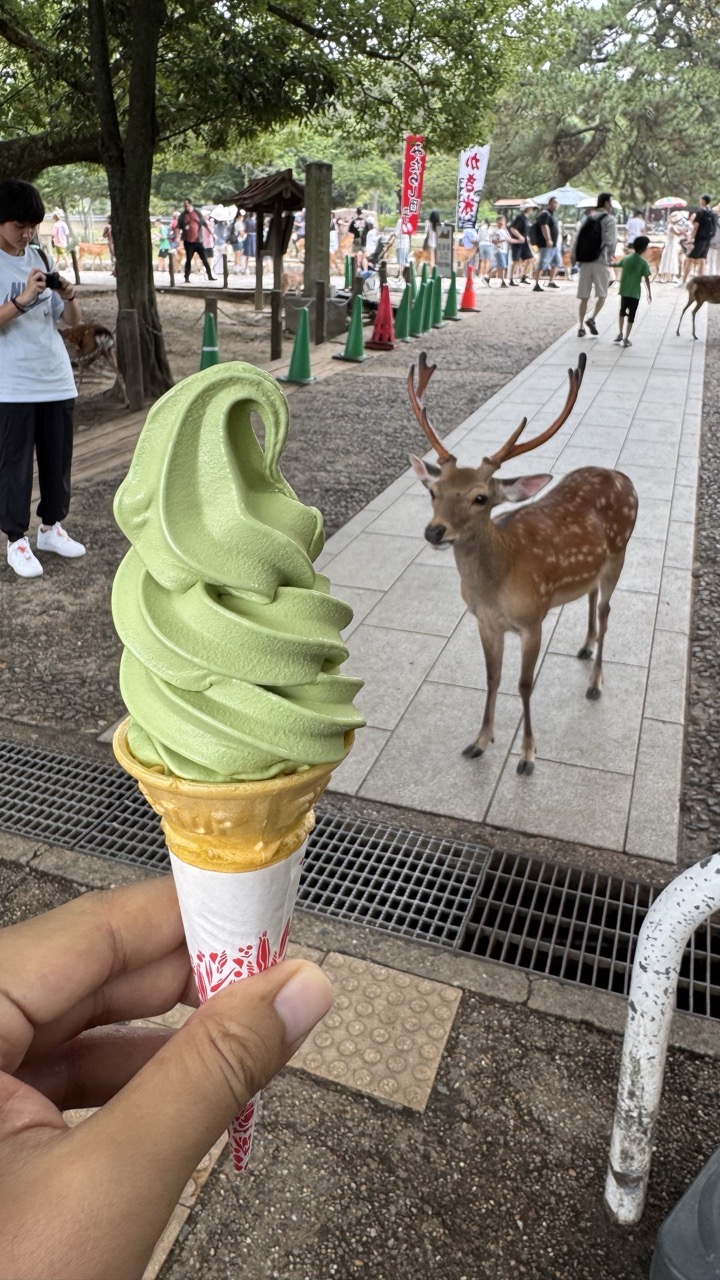

1. Overall Rating (0–10) — 7.0
This photograph captures a playful and whimsical moment at a deer park, where the juxtaposition of a soft-serve ice cream and a curious deer creates a narrative of unexpected harmony. The vibrant green ice cream draws the eye immediately, while the deer’s attentive gaze adds a sense of connection and charm. While the scene is lively and engaging, the slightly cluttered background and casual framing keep it from feeling fully composed, giving it the feel of a candid snapshot rather than a polished portrait.
2. Composition (0–10) — 6.0
The hand holding the ice cream is placed off-center, creating a diagonal line that leads the eye toward the deer. However, the background activity and scattered cones introduce visual noise, slightly disrupting the focus on the central interaction.
3. Lighting (0–10) — 6.5
Natural daylight provides even illumination, with soft shadows suggesting an overcast or shaded environment. The lighting is functional but lacks dramatic contrast, resulting in a flat yet clear exposure across the scene.
4. Color & Tone (0–10) — 7.0
The bright matcha green of the ice cream stands out vividly against the earthy browns and muted greens of the surroundings. The color palette feels natural and cohesive, with the red accents on the cone adding a subtle pop that complements the scene.
5. Creativity (0–10) — 7.5
The image succeeds in capturing a unique cultural experience—offering a treat to deer at a famous park—making it both relatable and visually intriguing. The composition cleverly frames the interaction between human and animal, suggesting a moment of gentle curiosity.
6. Technical Quality (0–10) — 7.5
The focus is sharp on the ice cream and the deer’s face, with clear detail throughout. The image is well-exposed, with no obvious flaws in resolution or noise, though the depth of field is limited, blurring some background elements.
7. Emotional Impact (0–10) — 7.0
There’s a sense of delight and lightheartedness in the image, evoking warmth and amusement. The viewer is invited into a moment of quiet wonder, where the innocence of the deer and the simple pleasure of the ice cream combine to create a memorable and heartwarming scene.
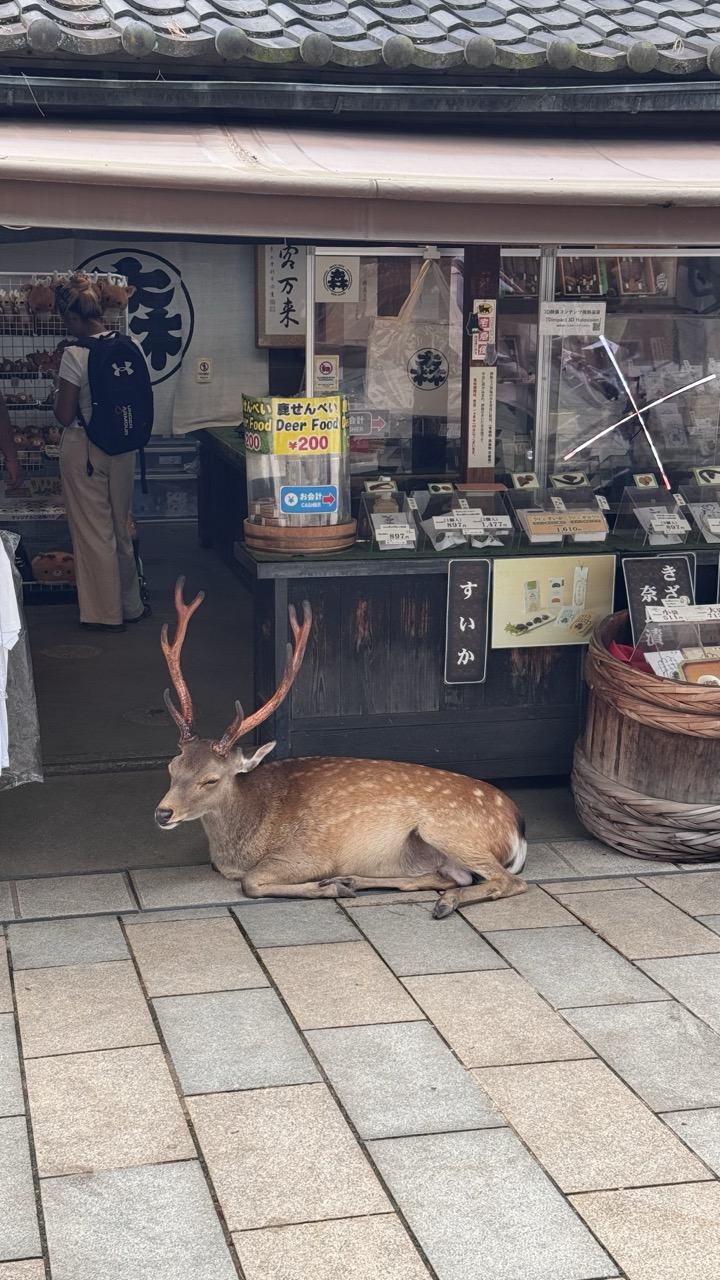

1. Overall Rating (0–10) — 6.0
This photograph captures a quiet, almost surreal moment where a deer rests calmly on a tiled walkway in front of a traditional Japanese shop, creating a compelling contrast between nature and commerce. The scene feels candid and authentic, offering a glimpse into the unique coexistence of wildlife and human activity in Nara. While the composition is grounded in reality, it lacks the visual tension or emotional depth to elevate it beyond a simple snapshot, and the cluttered background slightly dilutes the central subject’s impact.
2. Composition (0–10) — 6.0
The deer is well-placed in the foreground, drawing immediate attention, but the frame is crowded with signage, a basket, and a shopper, which disrupts visual flow. A tighter crop would better isolate the subject and emphasize the juxtaposition.
3. Lighting (0–10) — 6.5
Natural daylight provides even illumination, allowing clear visibility of textures and details. However, the flatness of the light, likely due to overcast conditions, softens shadows and reduces depth, giving the image a somewhat neutral tone.
4. Color & Tone (0–10) — 6.0
The palette is subdued, dominated by earthy browns, grays, and muted greens, which aligns with the natural and traditional setting. The deer’s spotted coat provides a subtle point of visual interest, but the overall tonal range lacks vibrancy.
5. Creativity (0–10) — 6.5
The image succeeds in capturing a culturally rich moment—deer in a tourist area, interacting with human infrastructure. Its strength lies in its narrative potential, though it leans more toward documentation than artistic expression.
6. Technical Quality (0–10) — 7.0
The image is sharp and well-focused, particularly on the deer, with clean detail in the tiles and signage. There are no visible technical flaws, though the slightly busy background affects overall clarity.
7. Emotional Impact (0–10) — 5.5
The deer’s calm demeanor evokes a sense of peace, but the surrounding clutter and the passive stance of the human figure prevent a deeper emotional connection. The scene feels more observational than evocative.
Loading map...